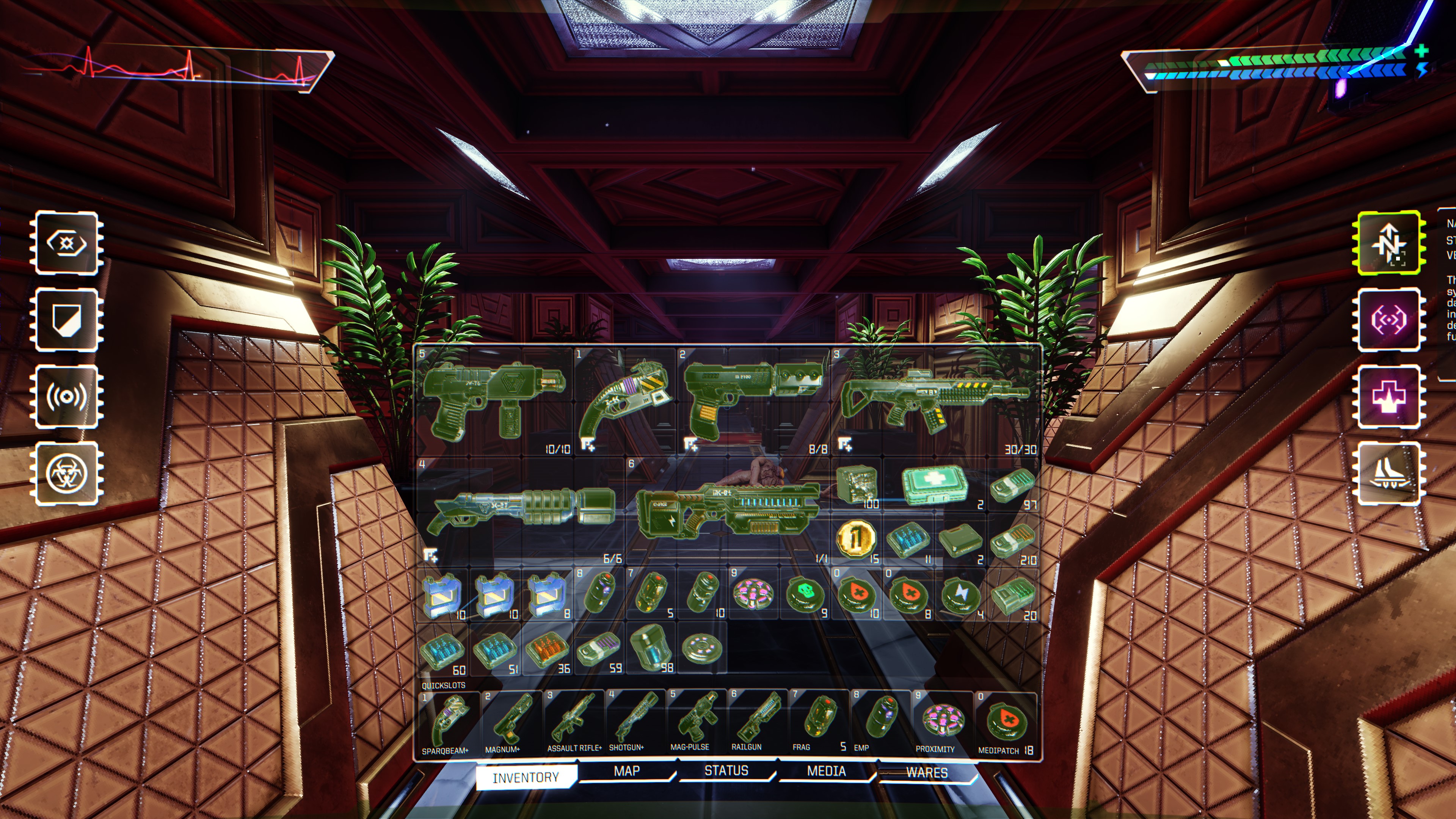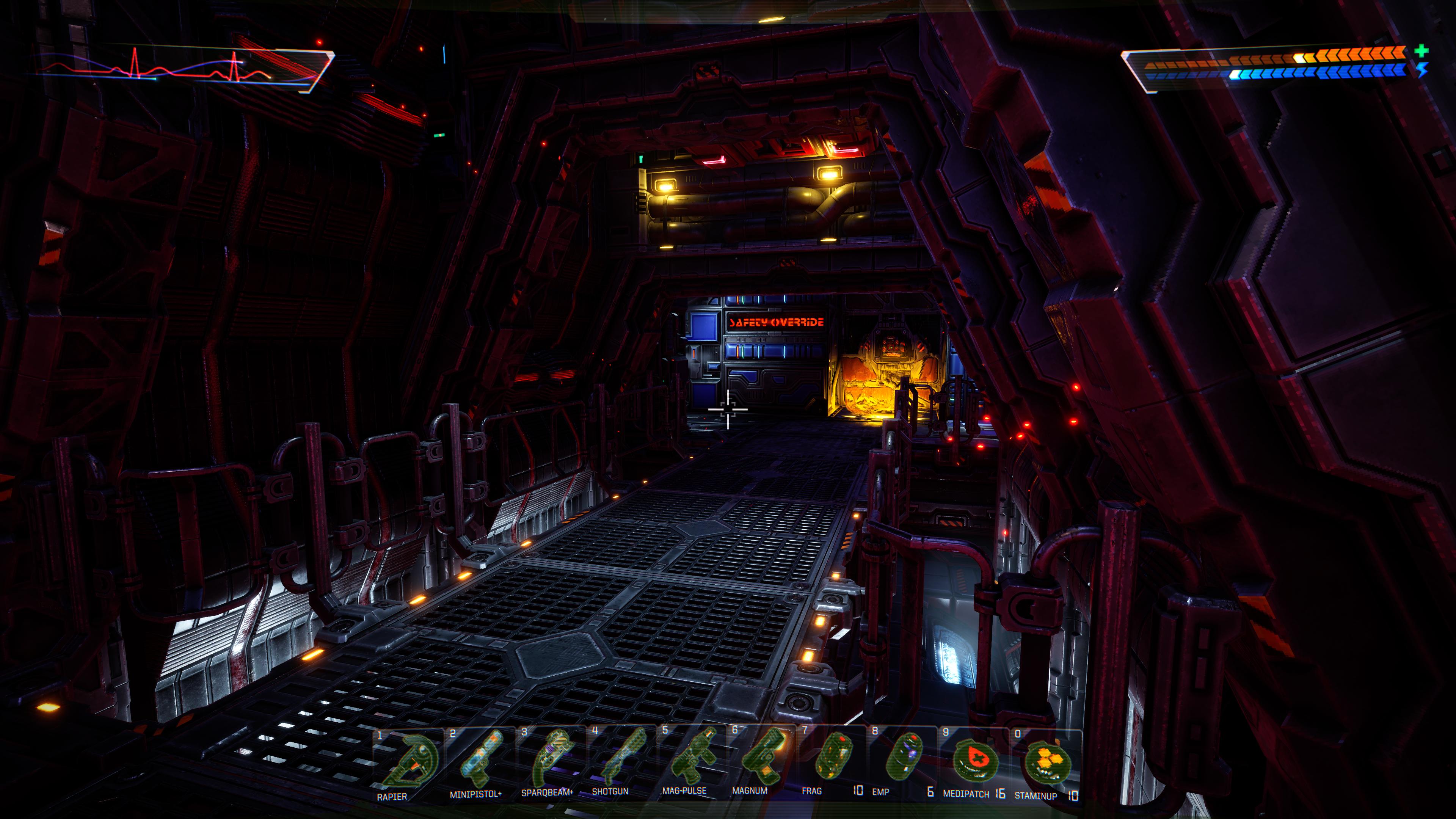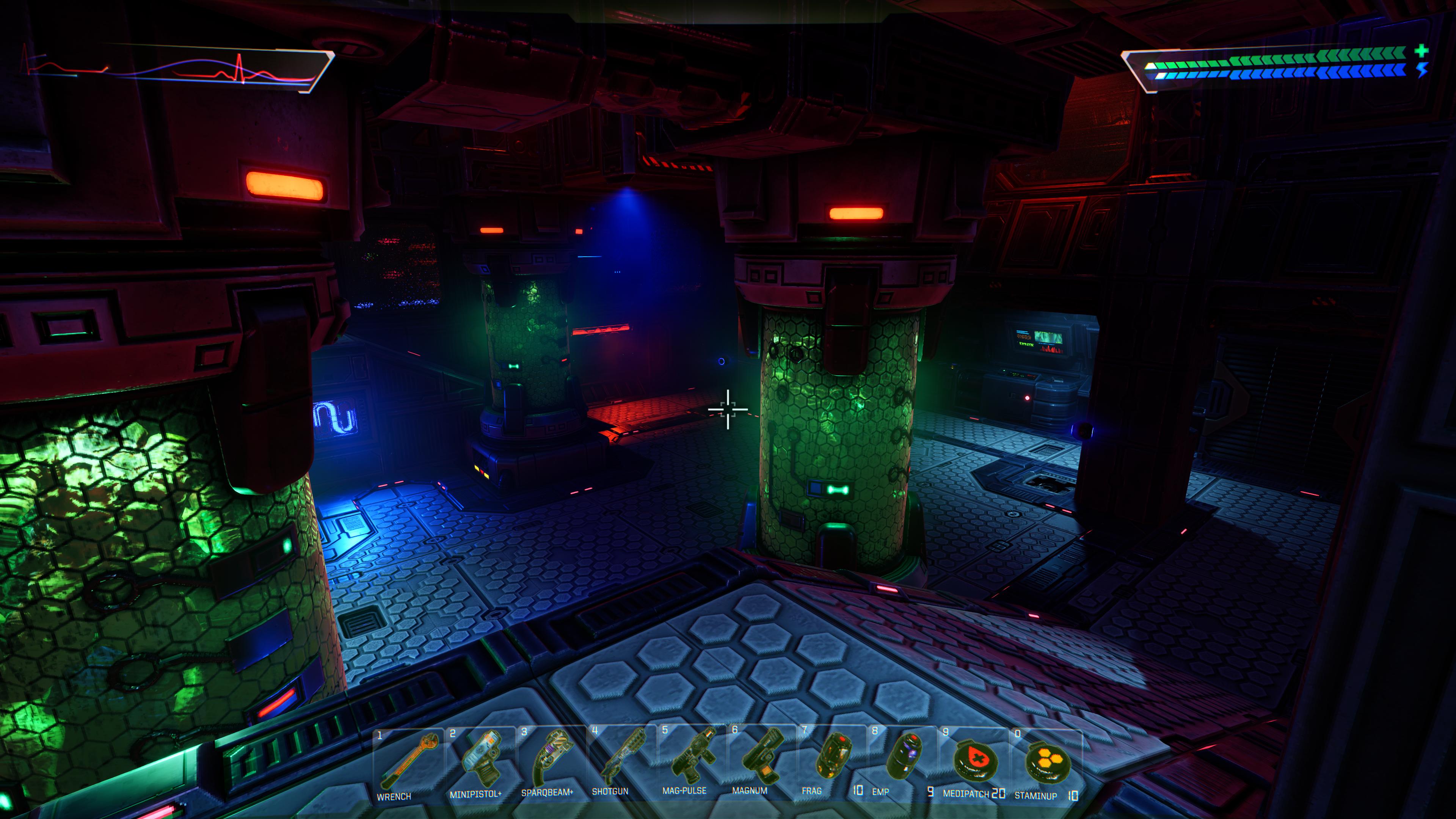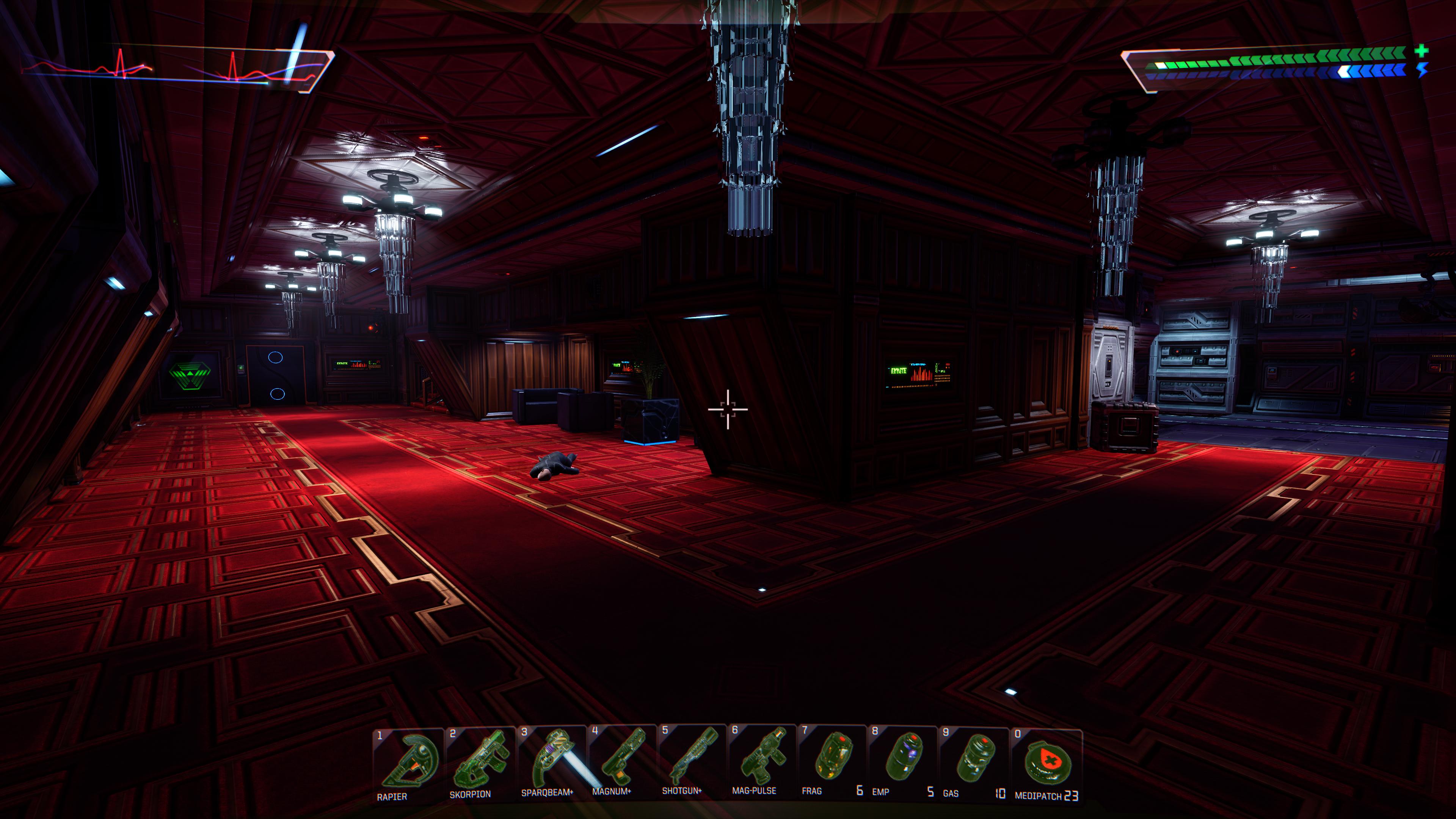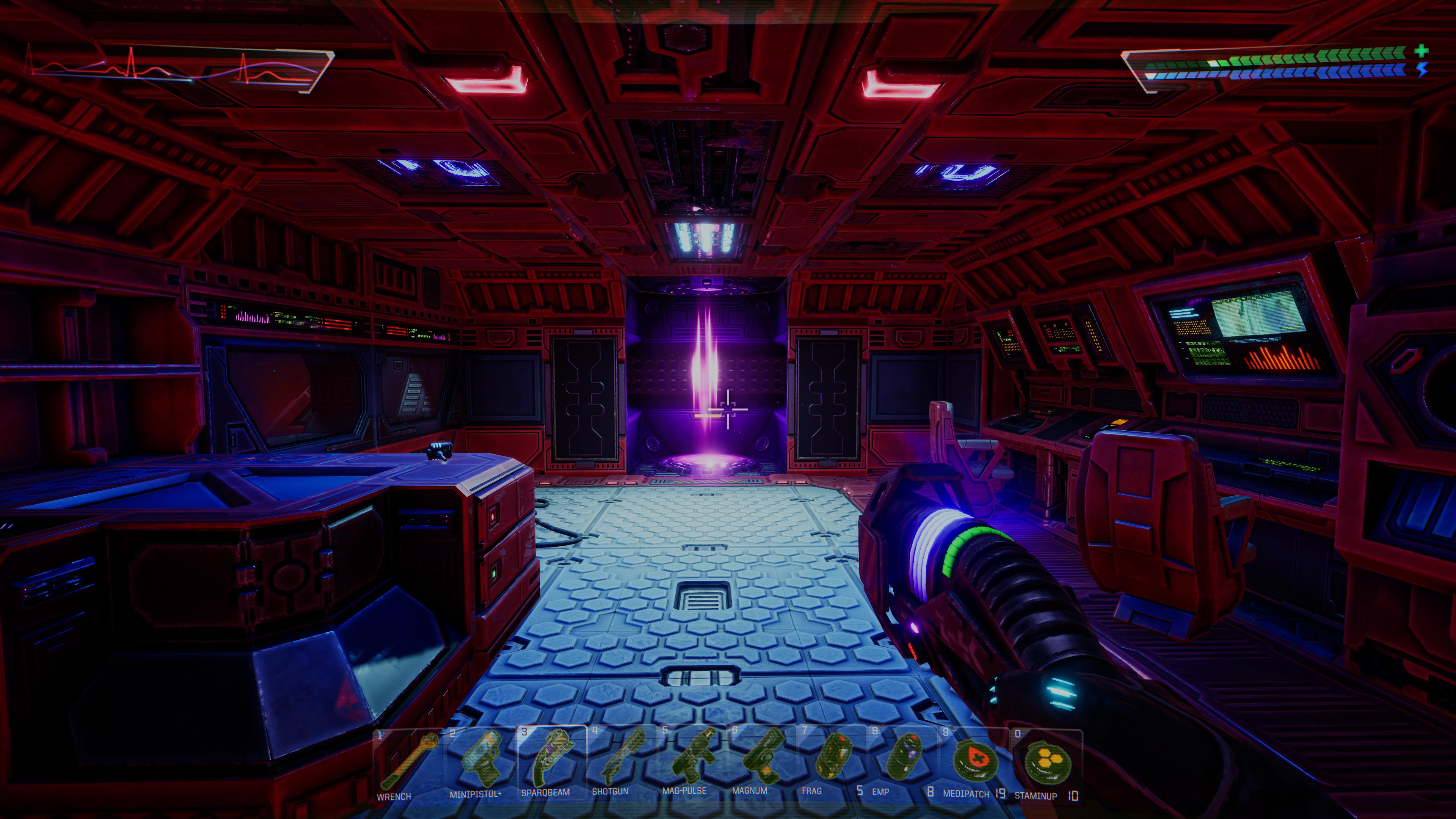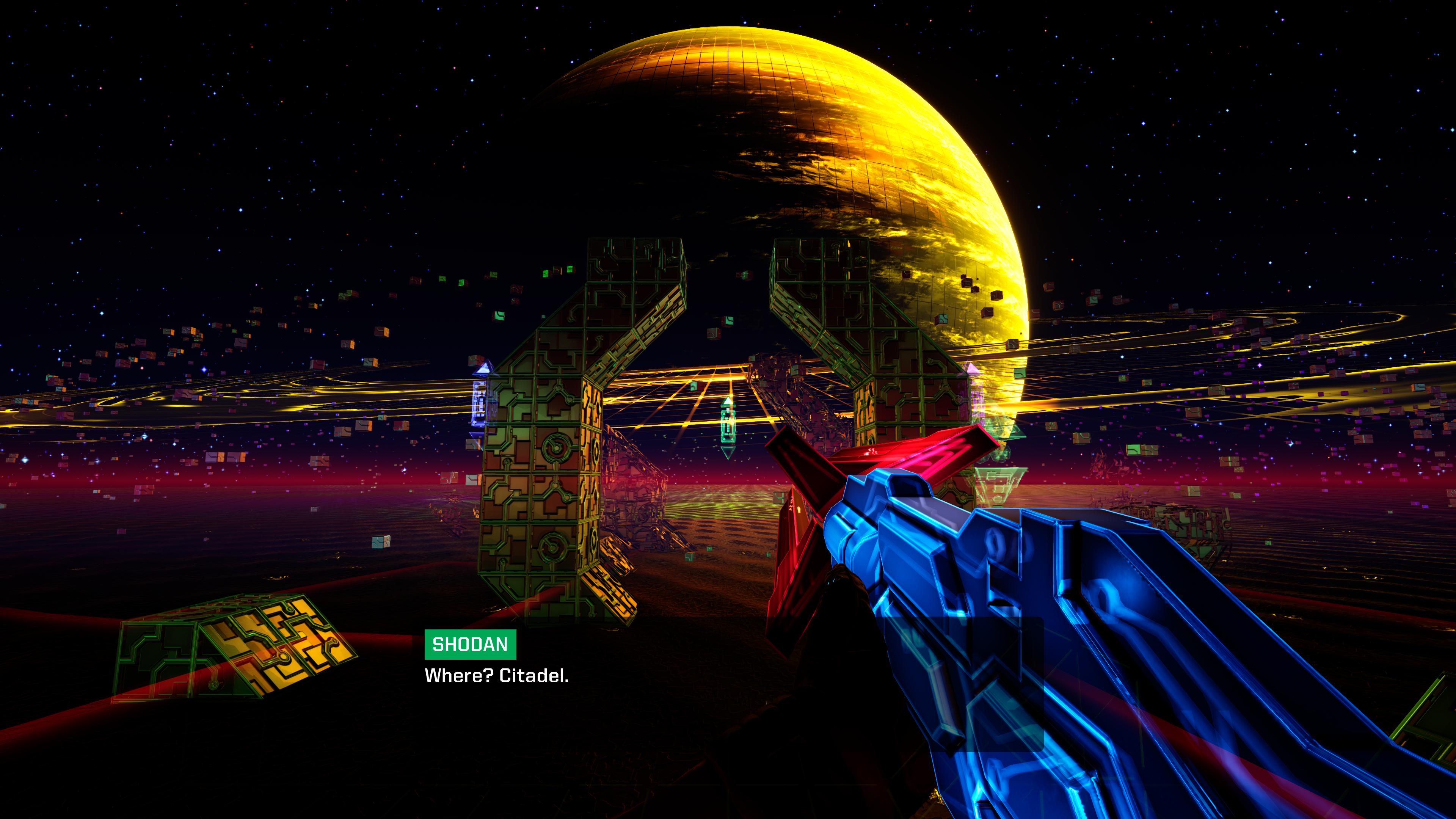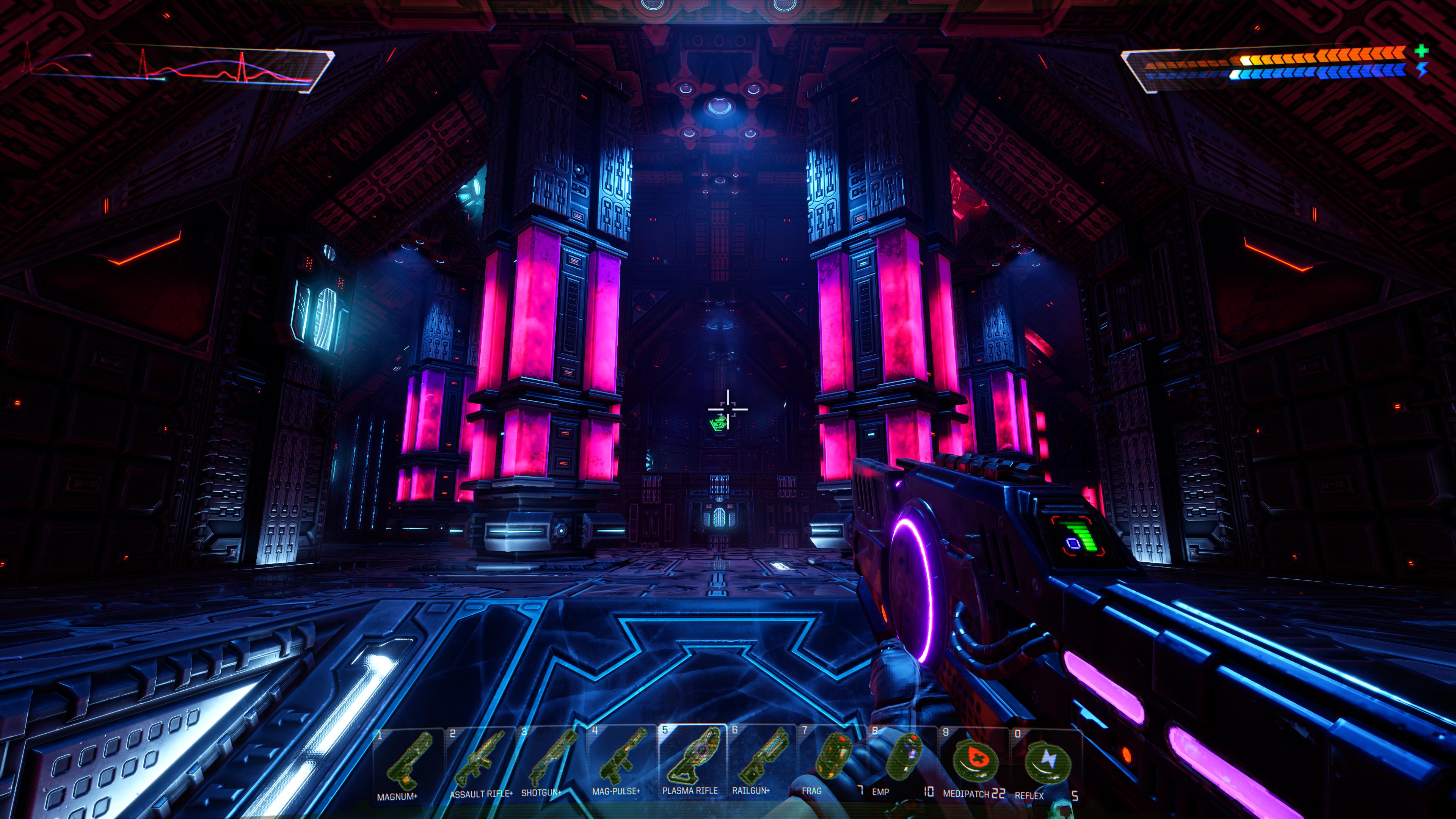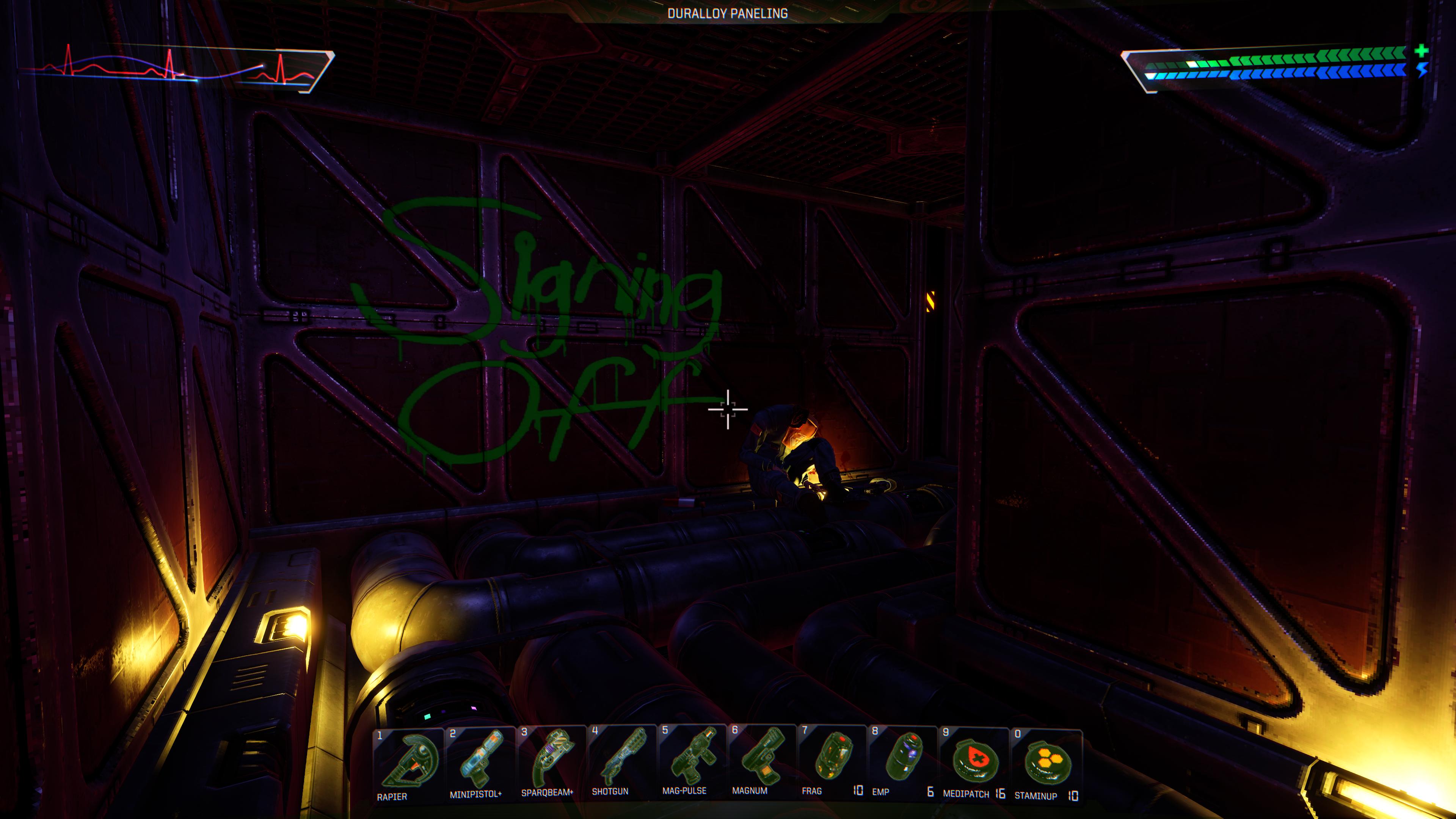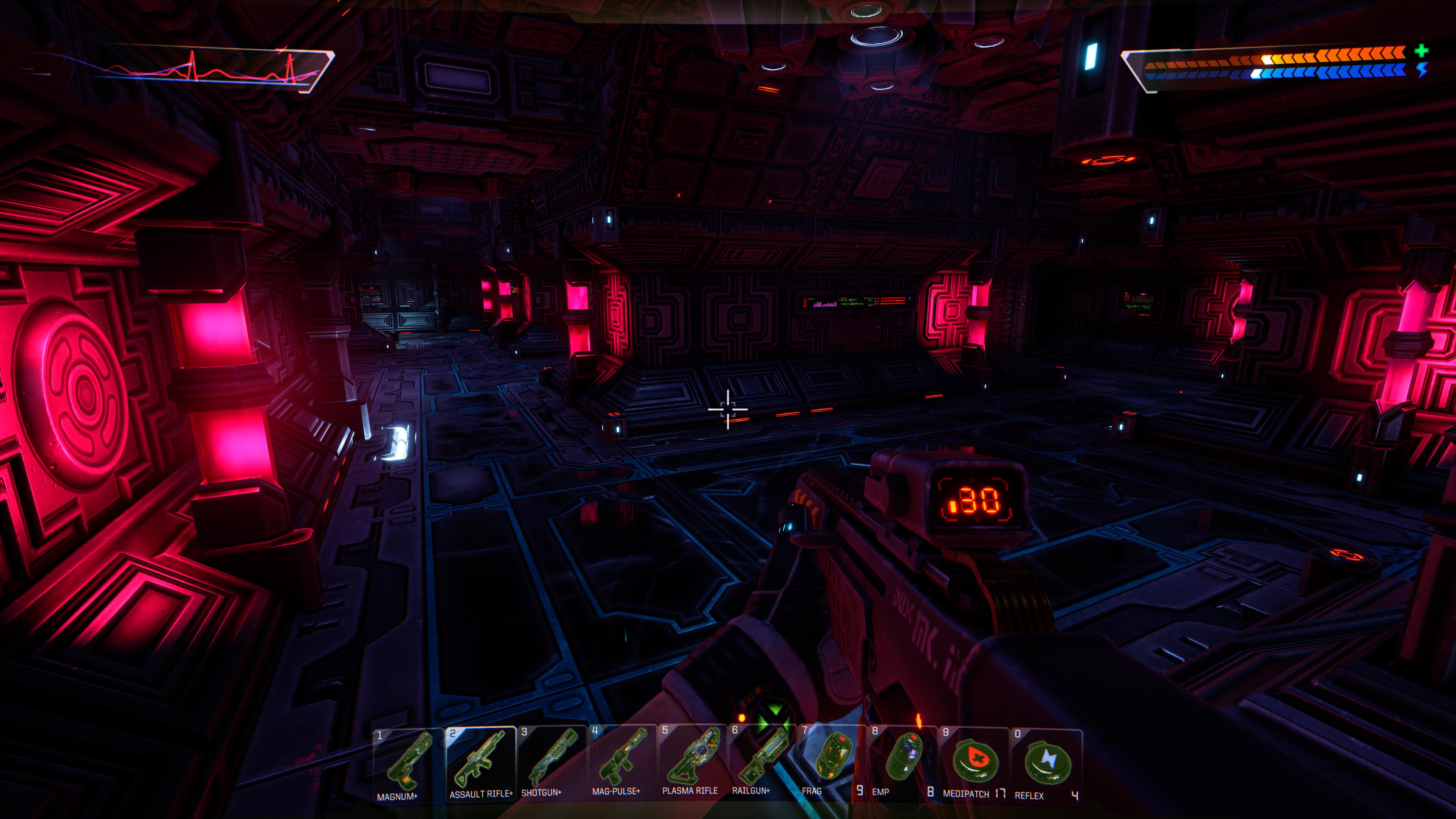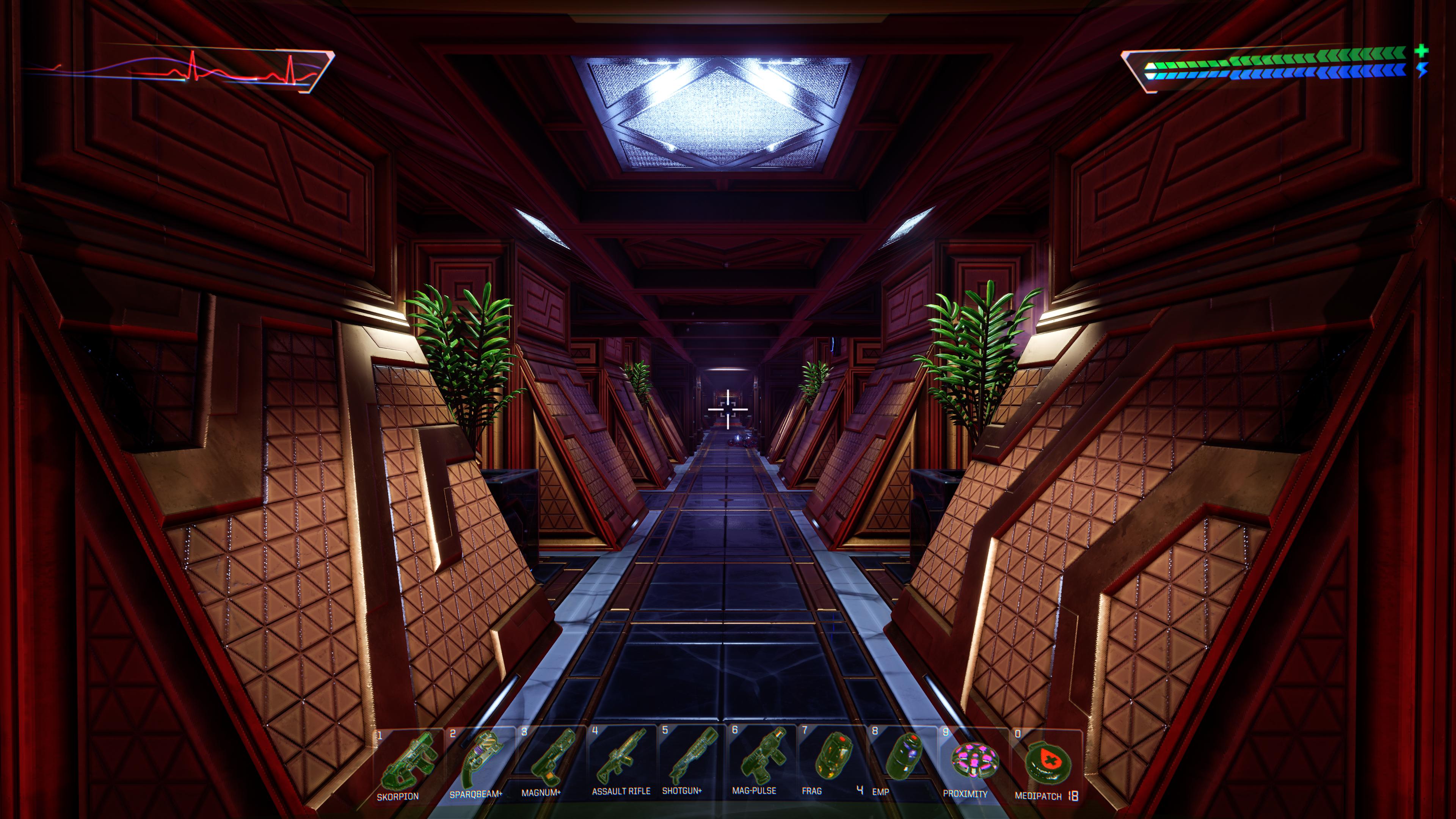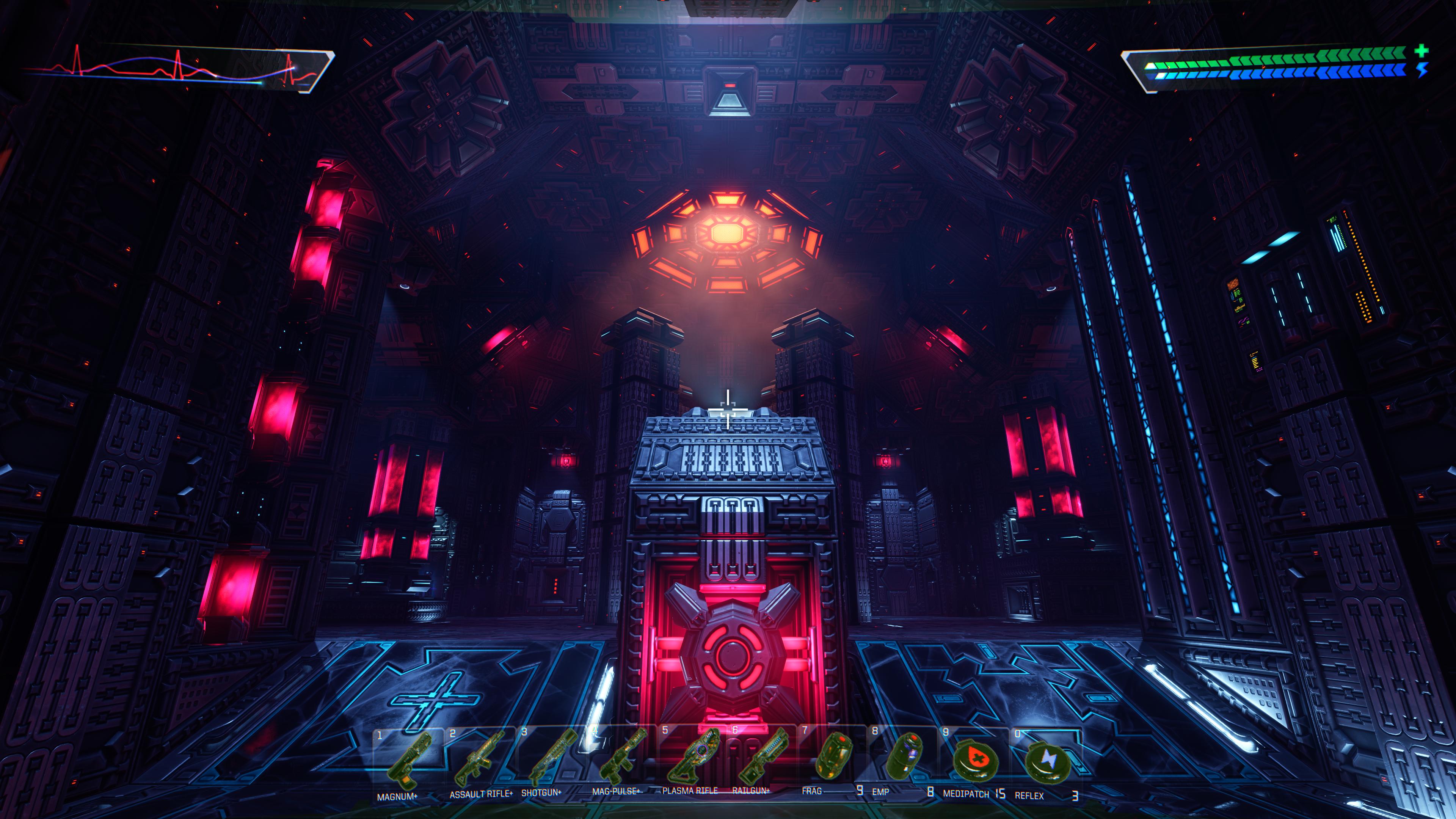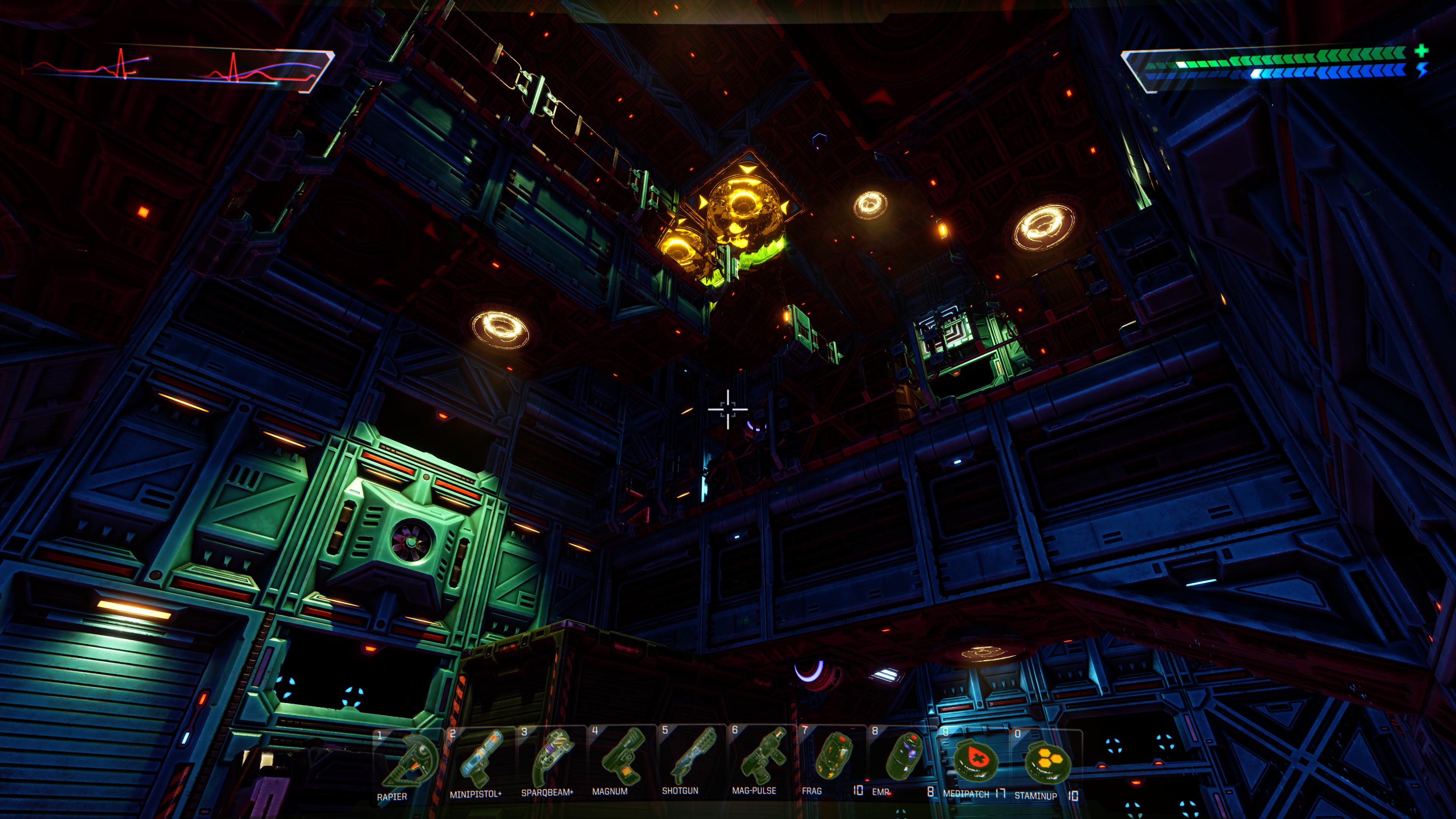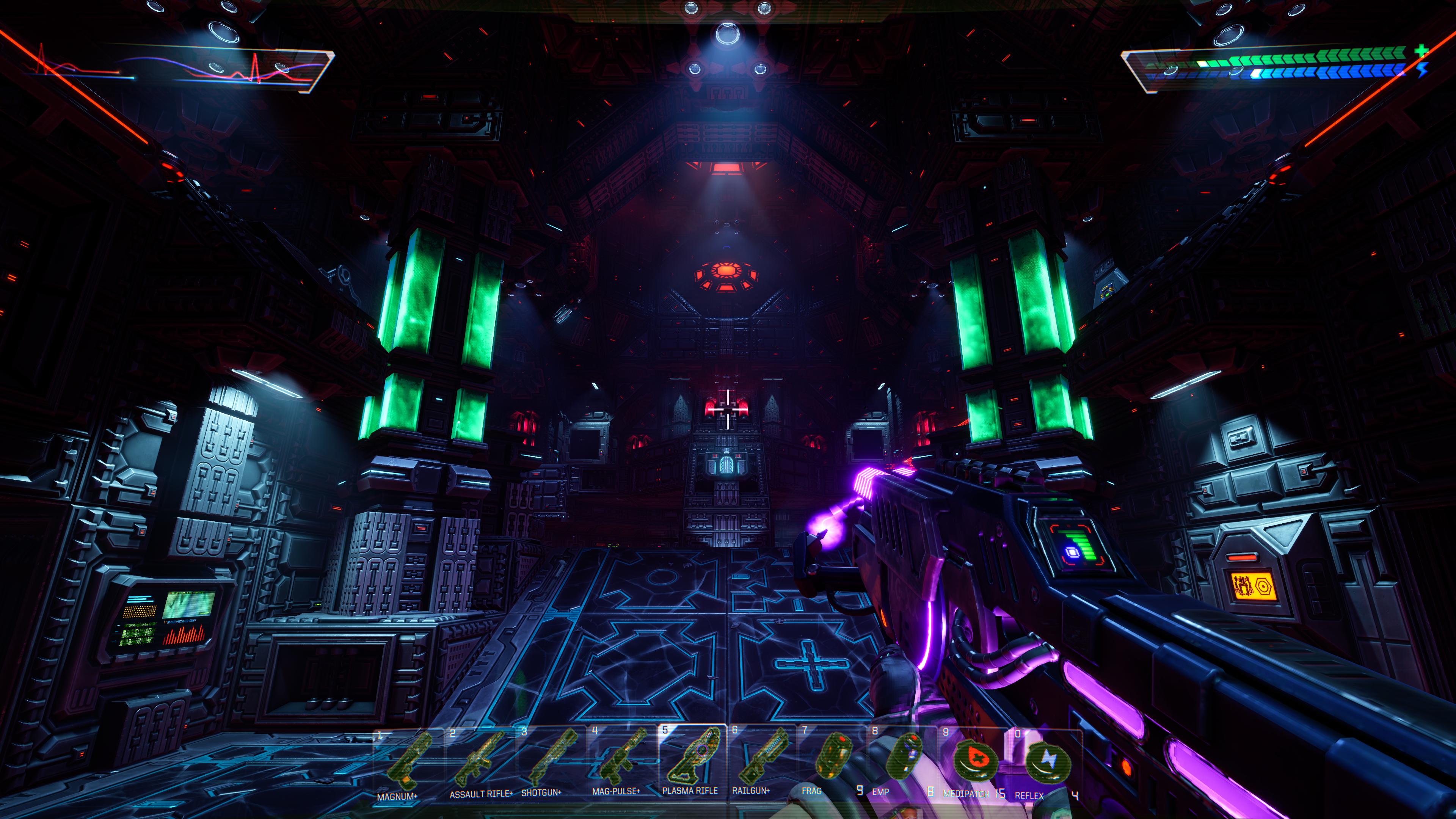System Shock was a 1994 PC game by Looking Glass Studios, a legendary game studio also known for the Ultima Underworld series (which System Shock draws inspiration from) and Thief series. They have one of the strongest resumes of any game studio, but those three early 1990s titles – System Shock and the two Ultima Underworld games – badly needed remakes. Now System Shock has one, and I hope the Ultima Underworlds get one although there is a wonderful spiritual successor called Arx Fatalis which I have yet to review here.
Nightdive Studios, who has created this remake, first remastered the game with System Shock: Enhanced Edition. In fact, System Shock was pivotal in the creation of Nightdive Studios, which essentially got their start by updating and re-releasing System Shock 2 using existing community updates. So the System Shock remake was truly a passion project for Nightdive, which made it very interesting from the start.
However, the game has had a rough development. It had a successful Kickstarter, but this remake began life on Unity engine rather than the current Unreal Engine 4.27.0 that it uses. The Unity version received criticism for being too different from the original, so they started over from scratch on Unreal Engine 4. This caused multiple delays, including an apparently very dishonest summer 2021 announced release date on Kickstarter.
But now in 2023 it is finally here (after a last minute delay), and we get to review it. Note that I have not played the original game, so I won’t be reviewing it as a remake. I’ll be reviewing it as a game. I did play through most of the first level (Medical) in System Shock: Enhanced Edition, but I just couldn’t stand the way the game/interface controls and plays in general. Enhanced Edition modernizes it to the best of its ability, but it’s still beyond what I can enjoy. I needed the remake.
So what is System Shock? Most people know of the BioShock series, but many aren’t aware that they are spiritual successors (of sorts) to the System Shock series, hence the name. In fact, the studio behind the BioShock games – Irrational Games – worked on System Shock 2 alongside Looking Glass Studios. But the BioShock games… they’re apples that fell very far from the tree. They were released in a different era; an era where much simpler games were dominating sales charts. As a result, the BioShock games only have a small fraction of the level design depth, gameplay depth and diversity, and challenge of the System Shocks.
BioShock is an FPS, while System Shock is a survival horror FPS with a much more interactive world and open ended narrative, while System Shock 2 adds copious amounts of RPG elements on top. System Shock is quite nonlinear, letting you backtrack infinitely (until reaching the penultimate level) and letting you choose what order you want to tackle some of the levels in. Environmental interaction isn’t deep but it is present in the form of many physics objects, interactive doors, lootable corpses, vending machines in the environment, not much else.
Arkane’s Prey is the better System Shock spiritual successor compared to the BioShocks, targeting the same amount of gameplay depth as System Shock 2 with larger scale but still very deep level design, maintaining the outer space sci-fi survival horror setting, but introducing the “perfect species” horror theme for even greater Alien inspiration than what the System Shock series already has. But that game remains a very mixed bag, having glimpses of brilliance but failing to deliver in survival horror while being overall underwhelming as an FPS.
The System Shock games (especially the second) are often referred to as “immersive sims” which is a bizarre, widely misunderstood terminology because it’s not self-explanatory in the slightest which is why it cannot be used as a genre label. It’s a design ethos brought forward by Warren Spector although he credited another with the term. Honestly, when breaking down the term it simply refers to an FPS with RPG inspired world interaction, without necessarily being a full fledged RPG. This being a 1990s term, when I say “RPG” I mean actual tabletop role-playing games were the inspiration for these “immersive sim” design elements; elements such as passive storytelling in the environment and being able to interact with the environment in all sorts of ways in order to be very creative in gameplay – this being referred to as “emergent gameplay.” Here are some specific examples for “immersive sim” design elements in games, but beware of the spoilers in the writing categories. It’s incomplete but descriptive enough to get the picture across.
Recommended Mods
System Shock has no mod tools but the game files can be extracted, edited, repaked using Unreal Engine 4’s (or even 5’s) UnrealPak.exe, and included in a mods folder which the game will read. I do recommend a few mods:
- Enable Texture Filtering – essentially disables the pixelation of textures up close. For those who don’t know, one of the controversial things about this remake is its pixelated and low resolution textures caused by 1990s style texture filtering, which conflicts with its modern PBR, modern shaders, modern post-processing, modern 3D texture mapping and tessellation, and mixed 2010s and 2000s polygon count. Try with/without, choose whichever you prefer.
- Simple Dot Crosshair or Smaller Crosshair – replaces the game’s annoying giant crosshair with a smaller one.
- More Difficulty – I haven’t tried this one yet, but it reduces enemy forget time and hesitation which addresses two AI flaws.
Gameplay
The colors are off in this video as I had enabled HDR via INI tweaks, which looks worse in this game due to it not being calibrated for it.
Ultimately the System Shock remake is a survival horror FPS, one without reliance on scripted encounters and cinematic storytelling. Enemy encounters are mostly dynamic, the player should explore every nook and cranny on every level to uncover the many secrets in order to maximize resources. I was very impressed with its demos of the Medical level, which showed lots of potential. I was glad to see examples of lessons learned from System Shock 2 in the gameplay. However, before deep diving into gameplay I have to get some UI complaints off of my chest. First of all, it is lacking an overall graphics preset option like every other game has – here, you have to individually set each one. Similarly, it’s lacking a “recycle all” button – recycling at recycling machines is a game mechanic I’ll go over later, but this is an obvious UI feature it’s missing (Arkane’s Prey has it). It also lacks an item splitting feature in the inventory, for splitting up say 10 medipatches into two groups of 5 or one 6 and one 4 or whatever you like. The game also completely lacks reticle customizability, but it does have UI color and transparency options at least.
It gets worse: I play the game on a common 16:9 resolution, which includes resolutions such as 720p, 1080p (Full HD), 1440p (QHD), and 4k (UHD). Despite this, the pop-up menus on the right side of the UI goes completely off screen as shown below. Even in fullscreen mode which is what I play on.
I also discovered while writing this review that if you press the Escape key while on the difficulty selection menu screen, it starts the game rather than going back. How unintuitive.
The UI clearly wasn’t tested well – in the updated demo earlier in 2023, there clearly hadn’t been any UI testing done. But one positive about it is that most of the HUD elements are optional and can be toggled off (but not the crosshair for some reason). The hotbar also has customizable behavior which is nice.
Now we can move onto the gameplay of System Shock remake. Being a survival horror game, movement is slow as it should be; reminiscent of System Shock 2 movement speed so slower than Arkane’s Prey. No complaints there, but I have other movement related complaints. As far as bugs go, clipping issues remain an issue. You can harmlessly clip through walls when standing close, you harmlessly clip through your player model when looking down and reloading, but you can harmfully clip into the environment and then get launched and killed both in realspace and cyberspace. Some polish is still missing despite all the delays.
Sprinting is present, but climbing/mantling is not. That would’ve required fundamental changes – dare I say improvements – to level design like System Shock 2 has. It would add another dimension to the gameplay (more vertical gameplay), but this remake prioritized authenticity so that wasn’t pursued. Fair enough, even though I would’ve liked to have seen such changes.
Movement does speed up when you unlock the turbo motion boots – an item that lets you sprint much faster (at a huge penalty to movement control while sprinting), and when upgrading further it provides jet boosters for slight upward movement in the air or breaking falls. Not nearly as much movement as jet boosters in Arkane’s Prey, and the clunkiness of turbo boots is partially unforgivable when your character gets stuck on crevices in the floor while sprinting.
One common complaint with this game since the demo is that it’s over-animated. Many complain about animated healing items, but I do not because it’s a survival horror game where such a thing is fitting, to make you have to plan more around healing or at least forces you to get to a safe place before healing. But the game is badly over-animated: every time you pick up an audio log, it’s animated which takes control away from the character, removing you from the game in anti “immersive sim” fashion. Also, picking up an audio log makes you move very slowly which makes you vulnerable.
This excessive animation is peculiar because Nightdive seems to understand the importance of retaining control over your character: you do in grav shafts, in surgery beds, in radiation treatment. I suppose they decided that many players wouldn’t notice that they picked up an audio log without the animation, despite the pop-up message on the screen when you pick one up. They are probably right but if anything they should make it an option that can be disabled.
Difficulty Modes
System Shock remake handles difficulty very well overall, and is only missing one or two important options. It offers four difficulty settings, each having three options:
- Combat Difficulty: Affects number of enemies, their health, their damage output, and their detection/aggression supposedly which I admittedly have not tested
- Mission Difficulty: On the easiest setting you are guided to your objectives via waypoints, which reminds me of Dead Space (which was originally going to be System Shock 3) and how you can deploy a line to your objectives on the ground. The middle setting has no hand holding, while the hardest setting imposes a 10 hour game time limit (my first playthrough took 21 hours for reference, but it’s clear how to bring it down to 10) and makes it so restoration bays (which bring you back from the dead after you activate them) only work on the level you’re on. Otherwise, if you die on level 9 and have only activated the restoration bay on level 1, then you’ll be restored on level 1 which to me is blasphemy but fitting for the easiest difficulty mode only: why bother having more than one restoration bay then? Especially for a corporation as greedy as TriOptimum, as I’ll reveal in the story review later.
- Cyber Difficulty: Cyberspace is a sort of mandatory minigame in which you connect your mind to a computer through a neural interface, which translates the binary code into bizarre visuals in what ultimately plays like flying vehicle gameplay in a world reminiscent of Tron. On the easiest difficulty mode it poses no challenge whatsoever, while enemy spawns in Cyberspace are normal on the other two difficulty modes but the hardest mode makes it so death in Cyberspace = death in realspace. Which is ultimately meaningless because the game autosaves right as you enter Cyberspace, so this doesn’t increase the stakes at all.
- Puzzle Difficulty: Self-explanatory. There are two types of puzzles in this game, both of which are gamified versions of electrical panels that are nothing like electrical panels and more like puzzle toys. They are actually tricky on the hardest difficulty mode and can take time, and this is coming from someone who plays the Myst series.
What’s missing is a limited save difficulty option. This could be baked into mission difficulty 3 or be its own option. Every survival horror game needs at least an optional limited save system to avoid save scumming. Especially a game with restoration bays to resurrect you after you die. I’m not the best at designing such systems, but considering the existence of restoration bays, I think a limited save system could work by only saving every time you enter a new level, every time you activate a restoration bay, and every time you successfully finish a Cyberspace adventure.
The other thing that’s missing not only in this game but almost all others is tying more AI behaviors to the combat difficulty mode. I specifically bring this up because of a major flaw and regression in this game compared to the demos (not the old Unity demo): Cyborg Assassin and Cyborg Mantis AI were gimped, and I’m guessing the reason is they defeated players too often in the demo. Cyborg Assassins would quickly throw a proximty mine, then flee and hide, waiting for a chance to ambush the player. If no such chance arose, they would resume their patrol but they used to avoid head-on engagements in favor of ambushes. This made for great cat and mouse gameplay, something System Shock 2 achieved with its very different Cyborg Assassins. This type of gameplay can really separate a great game from just any other game.
But in the full game, the Cyborg Assassin (not the Elite Assassin) just slowly walks toward the player shooting like a terminator, and almost every other enemy in the game behaves this same way. The AI is reviewed in greater depth below, but if you’re going to gimp your AI, gimp it only for the easier difficulty mode(s) at least. It’s not like they were overly challenging, cheating AI anyway, but leave the good AI on combat difficulty 3 at least.
The Cyborg Mantis was another sort of ambusher; a burly cyborg waiting around corners to leap out, deal massive damage, and if you tried to back away in the demo it’d ruthlessly pursue you with a leaping attack that covered great distance. Those guys beat me up and I anticipated both them and assassins, playing the demo while on the edge of my seat. Now the Mantis times its attacks much worse in order to be more forgiving, it barely uses its leaping attack and it only uses it from a farther distance where it cannot reach you. So now you practically cannot be damaged by the Mantis unless your hands are not on your keyboard/mouse or controller. You can just walk backwards slowly and blast them.
So the gimping of these two enemy AIs should have been limited to combat difficulty 1, maybe even 2 (I’d dispute that) but certainly not 3. In any case, I can only recommend maxing out the difficulty mode for every option on every playthrough, except for mission difficulty. Those new to System Shock should leave mission difficulty on 2, but veterans should consider setting it to 3.
This game has typical health and stamina systems, with sprinting and melee attacks temporarily depleting stamina. Health does not automatically regenerate, it is replenished via one of four possible ways:
- Food/Drink Items: You’ll mostly use these in the first two levels while you still have the inventory space for them. Unlike in Arkane’s Prey, this cannot be your main healing item in this game.
- Medipatches: This is the most common health item. It takes up one inventory space (you can stack 10 of them), its use is animated which is controversial but I say fitting for a survival horror game. It restores 35% health over 20 seconds.
- First Aid Kits: This health item is more rare, occupies two inventory spaces, you can only stack 3, and it instantly heals you 100% but the animation is longer.
- Surgical Machines: A fixed entity in the environment, only found on a few levels. Allows you to climb inside and be healed fully with no consequences, and it can be used infinitely. The only thing preventing its abuse is the optional 10 hour game time limit, or new enemy spawns if you try to use them without first seriously depleting the level security (more on this below).
In addition, the player has an electric energy reserve since you practically play as a cyborg yourself. Your energy also doesn’t regenerate, you must recharge yourself at charging stations or by using battery packs. There are two battery packs: one recharges you partially (probably the same 35% as the medipatch), the other fully but both share the same animation. Charging stations have to recharge for 1-2 minutes after being used.
There are other dermal patches in addition to the medipatches described above. The Staminaup stimulant does more than the name implies, providing infinite stamina and also +20 maximum health for 70 seconds. The Berserk Combat Booster increases melee attack speed by 50% and melee damage by 100% for 30 seconds, so it’s for melee combat only which means it isn’t useful after the first level (I never used any). Sight Vision Enhancement is self-explanatory, Detox Universal Antitode removes radiation and other toxins from the body, while Reflex Reaction Aid is invaluable slow-mo.
Using multiple dermal patches consecutively, before the effect of the first one ends, can result in overdosing and huge penalties. There are also side effects. If you scavenge a lot, these patches are plenty so you’ll never have to buy them at the vending machines that sell them. With the 10 hour time limit, I still don’t recommend buying any – there’s no need if you loot properly and quickly. Save your money for weapon upgrades. Another pro tip: save your Reflex Reaction Aids for the Cortex Reavers and the final level of the game (Bridge).
The inventory thankfully does not pause the game, and you can seamlessly drag items out of or into it. But it does limit world interaction more than System Shock 2 and Arx Fatalis – the two games with the most immersive inventories and UIs. There are two inventory size upgrades which must be found, and one is locked behind an actual chess game that you have to win against a chess AI, although the game does start with the player in an advantageous position that guarantees a victory in a few clever moves due to a deliberate weakness in the opposing chess AI. In addition to the inventory, you can store items in the cargo lift which is akin to Resident Evil’s storage boxes. This is supplemental, safe storage that you can summon to the medical room on every level.
Another relevant mechanic here is recycling. The environment is full of junk items (and here’s a warning that at least one of these is falsely labeled junk – credit chips) which you can vaporize by right clicking in your inventory and selecting that option, which breaks it down into raw material. Raw material, as well as some special junk items in the environment, can be recycled to produce coins. Coins can be used to purchase snacks/drinks (healing items), dermal patches, ammo, or weapon mods at the appropriate vending machines. Save them for weapon mods most of all. Different types of junk items yield different rewards, with special items on the Executive level being some of the juiciest along with damaged enemy weapons.
Thankfully the recycling mechanic isn’t balanced in such a way that it encourages recycling every single piece of junk item in the game. I’m going to just throw a number out there, but I’m guessing you’ll want to recycle around 1/4 to 1/3 of the recycle materials, along with some broken enemy weapons, if you want every weapon upgrade in the game and if you buy some ammo in the early game.
You will also notice security cameras in the environment. Unlike in System Shock 2, being seen by them doesn’t send enemies to that location to patrol – this is not an improvement that Nightdive chose to adopt. Instead, you’ll simply want to destroy the cameras, along with all of the CPU nodes on each level, to reduce level security. Reduced level security reduces the amount of new enemy spawns to none (not counting the few scripted spawns), and opens up new areas on the level.
Yes, enemies dynamically spawn in this game on previously cleared out levels, which is a standard for survival horror games. This is done to keep you on your toes and temporarily help prevent you from exploiting environmental resources like recharging stations and surgery beds. In fact, you’ll often see enemies brought up through the ground in a cage and then released, which is a nice touch as you no longer wonder where they’re coming from.
Here’s how I rate the overall difficulty curve of the game with combat, cyber, and puzzle difficulty on 3 (maximum) but mission difficulty on 2. The higher the rating the more difficult, and for reference a 10 for me includes the hardest parts of From Software games, the final level of Unreal: Return to Na Pali with Unreal Evolution mod on hardcore difficulty, the final level of Quake with Quake Combat Plus mode on nightmare difficulty, and the hardest parts of DOOM Eternal on nightmare difficulty. All nearly impossible. A score of 9 includes the likes of S.T.A.L.K.E.R. NLC 7’s hardest moments including the early game, as well as other levels in the aforementioned games that aren’t as hard as the 10s. System Shock 2’s hardest moments on impossible mode, with mods that make it harder such as RSD 2 and Scary Monsters AI, would score either an 8 or 9.
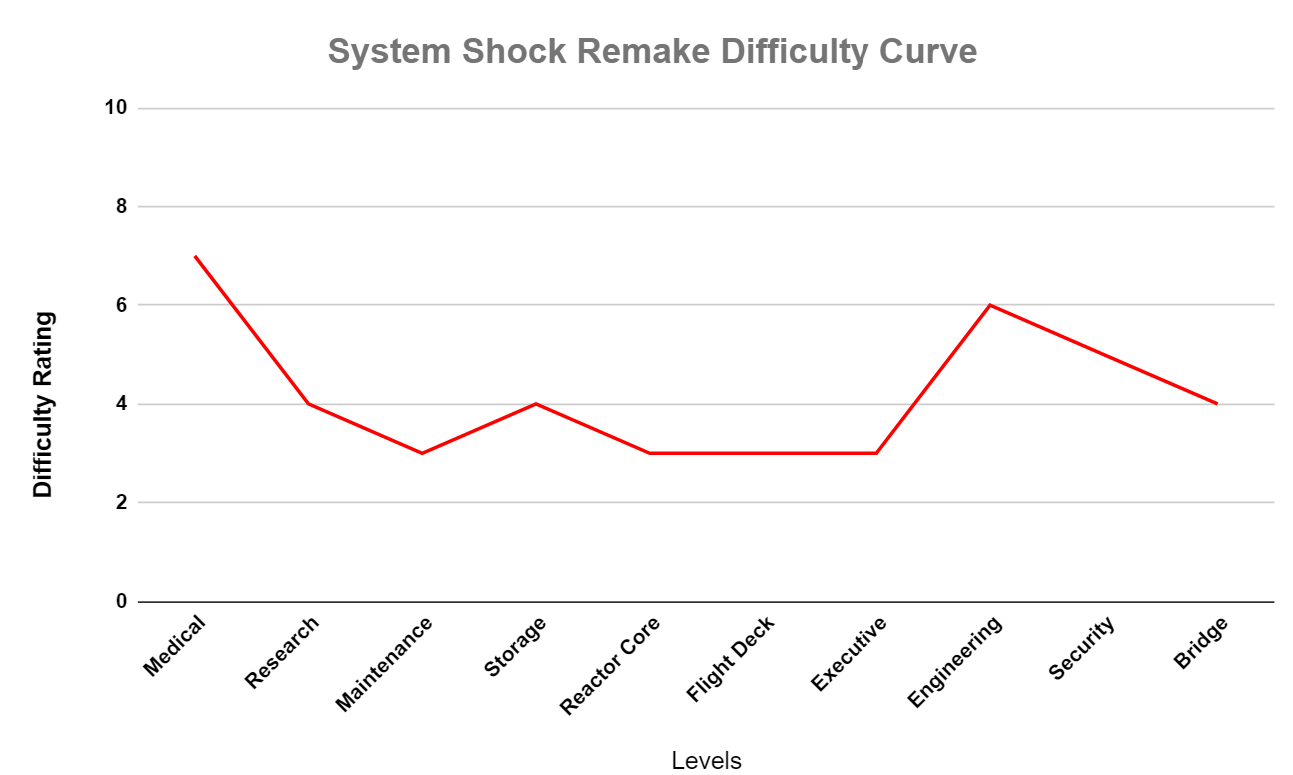
Of course, my difficulty scale won’t be the same as everyone else’s, so the takeaway here is the progression curve – the relative difficulty between each level. System Shock remake’s difficulty starts at the highest point, then dips and mostly levels out with the exception being a spike on Engineering, though that spike doesn’t reach the same heights as the beginning for a well equipped player.
This is not ideal for a survival horror game on max combat difficulty. What I want to see from such games is a gradually increasing line with a few spikes, like the one on Engineering, and I wouldn’t want anything below a 7 from a survival horror game on maximum difficulty. Medical can remain a 7 on my scale as it is now, but I don’t want to see any decrease from that. I might have preferred if Research was also a 7, then Maintenance, Storage, and Reactor Core increase to 8, followed by a 9 for Flight Deck and Executive, and then 10 for the rest of the game.
These are just arbitrary numbers though, so in practical terms what I would’ve liked to have seen was more diverse and punishing enemy encounter design on all levels after Medical, with difficulty spikes like the one on Engineering brutally consisting of cleverly placed Cyborg Enforcers, Cyborg Warriors, Security-1 through Security-3 bots, Cyborg Assassins, Cyborg Elite Assassins, Cyborg Mantises, Cyborg Elite Drones, Cyborg Elite Guards, Flier Bots, Mutated Cyborgs, Virus Mutants, with many of these being strategically placed to cut the player off and give them a deadly surprise while others attack from different directions. The same kind of brutality we get in System Shock 2.
Let’s compare this difficulty curve to one from Arkane’s Prey on maximum difficulty including all survival options, as well as mods that make it harder (Horror Typhons and Prey Core Balance + halfmat and halfammo). This game is fresh in my mind since I replayed it right before System Shock.
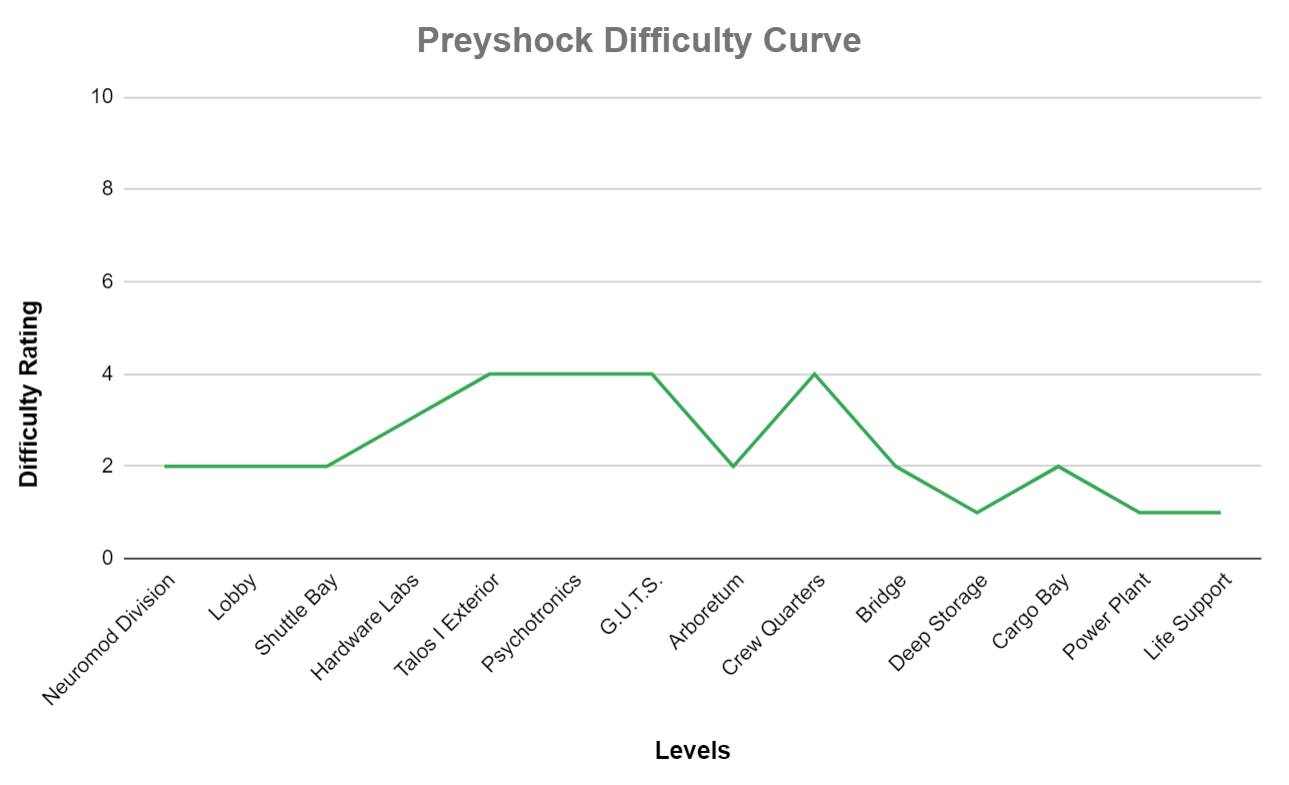
Of course, Arkane’s Prey is dependent on character build (which you can’t screw up permanently at least due to how many neuromods are in the game) and at what character level you enter each map at. So this scoring is for a strong character build using Typhon abilities, and it reflects the difficulty of each level when accessed in sequential plot order.
So we have an average difficulty of 4.2/10 for System Shock remake, and for reference 2.4/10 for Arkane’s Prey. I’ll recalculate this after finishing it with the 10 hour time limit, but I don’t expect it to change much. Unfortunately I can’t score System Shock 2 with this level of precision right now, but I’ll add that here after replaying it again soon. I do clearly remember that it generally follows the ideal linear increasing progression curve. I also can’t score BioShock since I haven’t played that in well over a decade, but I do know that scores even lower than Arkane’s Prey.
Is System Shock remake a proper low resource survival horror game? Not quite. There is no direct equivalent to System Shock 2’s “Impossible” difficulty mode, one of the best low resource survival horror games there is. There isn’t even a direct equivalent to System Shock 2’s hard mode. The only way this game becomes an acceptable survival horror game beyond level 1 is with mission difficulty 3 and its 10 hour time limit, which will feel cheep to some. Dermal patches, most ammo types (not plasma cores or railgun projectiles), and normal battery packs are plentiful, but with the 10 hour time limit you’ll use more of them and possibly obtain fewer.
Still, it is certainly a better survival horror game than Arkane’s Prey which is only dressed up as one. The BioShocks don’t even bother dressing up as one really.
Melee Combat
Looking at the combat of System Shock remake, one thing has polarized players since the demo, and that is the melee combat. Complaints range from the hitboxes to the lack of “impact”. Many of these complaints are actually exaggerated and misleading, but there are indeed issues with the melee combat. Hitboxes are not the issue – the hitbox from the player’s weapons are extremely precise as they should be. Many players expect exaggerated range from their melee weapons, but this game simply doesn’t exaggerate it which is again how it should be. The real problems with this game’s melee combat are that it’s impossible to justify using it aside from killing mutants to save ammo in the early game. After this, even with the very powerful laser rapier, it’s not worth keeping it in the inventory just for the rare sneak attack or Cyborg Mantis fight or enemy disabled by an EMP. Melee has no other uses.
Furthermore, FPS games seriously need to level up their melee combat in general. This applies not only to this game. System Shock has your usual standard melee attack and a more powerful one that involves holding a mouse button. No blocking, but other FPS games will have a block and a perfect parry block, and that’ll be the extent of the melee combat in almost all FPS games. It’s half-assed. Take queues from the few games that specialize in first-person melee combat mechanics – games such as Dark Messiah, Dishonored, the modern Shadow Warrior games (ignoring their balance and other issues) – and add some depth, some combat diversity, via things like combo attacks derived from combining movement keys with the attack button, as well as more detailed enemy reactions to being hit in different areas. This could’ve made the laser rapier interesting to use.
Shooting Mechanics
Things are much better when it comes to shooting mechanics thankfully. The mechanics themselves are nothing special or unusual (and surprisingly there is an aiming mechanic, though without sights/scopes), but the weapon design and diversity stand out. Here’s an interesting comparison: Arkane’s Prey is a 30-40 hour game with just 5 “guns.” BioShock only has 6 guns in its 8-10 hour length. System Shock remake on the other hand is a 10-20 hour game in which the very first level has 4 guns – only 1 fewer than all of Prey and 2 fewer than BioShock. That’s embarrassing for those games. Both System Shock games always excelled in weapon diversity, thankfully this remake is no exception.
This game does have leaning thankfully, it’s a must here. Some guns use bullets, others use your energy reserve, and some others use both. Energy is also used for various items which I’ll cover below. But when it comes to weapons, System Shock remake has the following, and no you cannot loot enemy weapons and use them but you can loot ammo (some of the enemy ammo drops also make no sense):
- Lead Pipe: The first melee weapon
- Wrench: Hidden melee weapon, more powerful than the lead pipe but a tiny bit less range
- Laser Rapier: Melee weapon that draws energy, very powerful but only useful in a small handful of scenarios
- KE-41 Minipistol: A compact toy-looking 9mm pistol with a 10 round magazine (upgradable to 20), a fairly slow semi-automatic firing rate (upgradable to a toggleable 3-round burst which increases its inventory size). There are two types of 9mm rounds – standard (20% penetration) and Teflon (50% penetration). All AP ammo variants deal the same damage so they are flat out superior. This pistol is obsoleted by the weapon below.
- KF-18 Skorpion: 9mm submachine gun so it uses the same ammo as the above pistol, but has a 30 round standard mag that’s upgradable to 50 rounds, and has a fully automatic firing mode. It has devastating DPS – with Teflon rounds it is a threat to all enemies. It isn’t even that much bigger in the inventory than the upgraded pistol, so I don’t think anyone would ever keep the pistol over this.
- Magnum 2100: Magnum pistol with 8 round capacity upgradable to 12. In true 1990s survival horror game fashion, it’s one of the strongest guns in the game, being even stronger and with better penetration somehow than the assault rifle. Great against everything.
- SK-27 Shotgun: Pump-action shotgun with 6 round capacity and two ammo types: flechette rounds and dragon’s breath. Flechette has good penetration but Dragon’s breath are the only non-AP rounds that are actually more powerful than the AP round. Use Dragon’s breath on fleshy targets.
- MARK III Assault Rifle: By default this has a 24 round magazine (upgradable to 30 rounds) and 3-round burst fire (upgradable to full auto). Sounds like a 5.56, low recoil too. You can fire either magnesium-tipped normal ammo or penetrator ammo which again has no downsides. Great against everything, but the game missed an opportunity by not giving this (and some other guns) a cool optic upgrade; perhaps a truly holographic sight like in Half-Life: Alyx for the Skorpion and a picture-in-picture computerized variable zoom scope for this.
- MK-84 Accelerator Railgun: The most powerful gun in the game, more than the grenade launcher even. Fires one shot at a time and has a very long recharge time (upgradable). Save it for the final level.
Those are all the melee weapons and the guns that only consume ammo above. The pistol is the only gun that becomes totally obsolete, while the Laser Rapier obsoletes the other two melee weapons but in my opinion becomes obsolete itself. System Shock 2 makes melee (psi-melee specifically) more useful.
Now let’s look at the energy weapons. These consume your energy level, but two of the guns also use ammo (one of them optionally).
- Sparqbeam: An electric pistol with three power settings: low power and low damage, middle, and extreme. Extreme has a cooldown too, and each power level is indicated by a light on the gun as well as particle effects from the gun.
- RW-45 Ion Rifle: While consuming far more inventory space than the Sparqbeam, I cannot imagine keeping the Sparqbeam. This does far more damage on each power setting, though on the middle and high settings it ricochets violently which makes it dangerous to use in close quarters but it’s another method of attack.
- LX-XX Plasma Rifle: As many X’s as the XBOX Series X and RX 7900 XTX! It also clearly surpasses the Ion Rifle. Has only two modes: the first one only uses a little bit of energy for moderate damage, the other uses ammo too and on this mode it is the second most powerful gun in the game in raw damage output, but its projectile ricochets all over the place for some time. I’ve killed myself with this one but it has also saved my life.
- JW-76 Mag-Pulse Rifle: You can get this on the very first level of the game yet it’s one of the most useful guns against robots (and still great against cyborgs), don’t use it against organics. It has two firing modes, the second one firing two shots thus using twice as much ammo. By default, it doesn’t consume energy, but an upgrade makes it consume slight energy for a substantial power boost. Its damage is transferred to the enemy over 3 seconds, so keep this in mind – stay in cover after shooting it. It’s a projectile weapon that doesn’t shoot straight over long distances.
Weapon upgrades are rare in this game and specific to one gun. The upgrade system is better than having none, but isn’t the most creative.
There are also explosives, and thankfully the game allows for cooking grenades! A badly underutilized mechanic. Also, enemy frag grenades (and rockets) will instantly kill you on combat difficulty 3, so be very weary of those. You can’t throw grenades back but you can try and shoot them. Also, there appears to be a bug in which you can throw a grenade, it’ll explode, but it’ll leave behind a lootable grenade that you can reuse.
- Frag Grenade: Unlike most games, it actually has shrapnel. Extremely useful.
- EMP Grenade: Disables robots/cyborgs but also the player. Extremely useful.
- Gas Grenade: Only good against organics. You’ll use these less often than the rest.
- Proximity Mine: It emits a pink light and sound, it’s the same one used by Cyborg Assassins. Very useful since no enemy can detect it, they all walk right into it because this game doesn’t have the courage of Unreal to make some enemies avoid obvious traps.
- EM-83 Grenade Launcher: Even though its model looks like a toy revolver grenade launcher, it only holds one grenade for some reason. It sacrifices a ton of inventory space for longer range, detonation impact of grenades, and a damage upgrade if you find and install it. I couldn’t justify its use especially since I love cooking grenades.
The weapon diversity is very good, the creative design of the weapons shines in the Ion and Plasma Rifles, and the balance between the projectile weapons is good (it’s not a crime to have some be clear upgrades), but the weapon upgrade system is unremarkable. It is welcome and improves the game, but there’s room for a lot more. Nightdive should’ve taken a look at this mod for System Shock 2, both for weapon upgrade inspiration and a lot more.
Ammo selection would be a lot more meaningful if the game was a proper low resource survival horror game at least on one of its difficulty modes, but the 10 hour time limit helps a bit here. It really relies entirely on that for any challenge after level 1.
Other Combat Mechanics
Weapons aren’t the only tools in the game. There are also hardware attachments for the protagonist to install, with optional upgrades. Here is a breakdown of the ones with significant gameplay impact and optional upgraded versions:
- Sensaround Radar Unit: Reveals items of interest around you on the minimap.
- Energy/Projectile Shield: Turn this on to reduce damage taken from projectiles, and an upgrade exists to add protection against energy weapons.
- Environmental Protection Pack: Turn this on to reduce damage taken from environmental hazards such as radiation and bio-contamination.
- Head-Mounted Vision Unit: Starts as a flashlight, can be upgraded into night vision and then night+thermal vision. This never has to be used though; I never used it and I have the in-game gamma/brightness set to recommended, normal values on a calibrated OLED display. The game has breakable light sources but too much ambient static light to warrant the use of this, there’s no pitch darkness which is unfortunate.
- Target Identifier: Analyzes enemies for their status as well as weaknesses when upgraded, can detect invisible mutants, and can even be used to hack some robotic enemies though the game doesn’t tell you how to use this from a control/keybinding perspective.
- Turbo-Motion Boots: Mentioned earlier in the review but this increases movement speed when active but it ruins control over the character at the same time, is a bit clunky, and allows for reaching new areas vertically.
All of these weapons and other mechanics create adequate diversity for the game’s 10-20 hour length, far more gameplay diversity than most games provide. Melee combat has questionable value at best and is mechanically dull, as does the head-mounted vision unit, but from a combat gameplay mechanics perspective I have no other real complaints, but these mechanics don’t live in a vacuum. Let’s now bring AI into the picture.
AI
Well it seems I couldn’t help myself earlier since I’ve already covered the most important AI topic for this game: the impressive (albeit still work-in-progress) Cyborg Assassin AI and Cyborg Mantis AI from the demo being ruined, made into harmless, simple, ineffective boring enemies like the rest. Okay, but very few single player games succeed at creating individual enemies with impressive AI capable of making for engaging, dynamic gameplay, but that doesn’t mean we shouldn’t demand better. Especially when System Shock 2 succeeded at this, and especially when a modder tidied up most of the flaws in System Shock 2 AI.
Enemies fall into one of three categories: mutants (organics), robots, and cyborgs which are a mix of both. Despite this, almost every enemy AI in System Shock remake is a simple terminator-like creature that slowly approaches while blasting you with no sense of self-preservation. Yes, they are all mind-controlled by SHODAN, and yes some are cyborgs like terminators are, but that doesn’t mean they should all be so combat ineffective. This simple terminator AI is adequate for some of the game’s enemies, but not most.
I have no complaints for the following enemy AI:
- Humanoid Mutant: This one was actually nicely improved over the demo with the addition of a charge attack that creates interesting melee gameplay (it can be countered). These are basically zombies.
- Virus Mutant: Variant of the above that’s actually fairly dangerous in numbers, the game just doesn’t use them enough
- Zero-Grav and Alpha-Strain Mutants: Serves as a simple, almost passive deterring enemy
- Inviso-Mutant: Invisible version of the above can be a decent surprise at times
- Gorilla-Tiger: Simple charging beast but it serves its purpose, just underutilized again
- Plant Mutant: Basically just a hidden turret, which is fine but they’re underutilized in Beta Grove
- Serv-Bots: They’re not meant for combat after all, so I’m fine with them
- Maintenance Bot: Meant to move cargo around not fight, so this AI is also fine
- Security-2 Bot: This works as a simple terminator
- Hopper and Mobile Laser: Very similar enemies, both just mobile turrets so they’re fine, just overused Reactor Core level
Here are the enemies for which I take issue with the AI:
- Avian Mutant: This dinosaur-like mutant just flies slowly towards you in a straight line, so an aerial terminator. You have all the time in the world to prepare for their advance. They look way more capable than this and because of their slow linear flight path, they barely take advantage of being airborne. Needs a complete redo – they should fly quickly, they should avoid flying straight towards the player, they should swoop in as opportunists like many birds like to do. This would make them individually much more dangrous and engaging, so the big waves of Avian Mutants would probably need their numbers reduced, which also benefits performance on old computers. Unreal has a good AI for this type of enemy with its airborne bird-like creature, copying that would’ve been great.
- Cyborg Drone and Elite Drone: Give them basic tactics, even if it’s just like Half-Life 2’s Combine. They need to acknowledge each others presence and work together: if there are multiple of them, they should try and approach from different directions to flank the player. They should have a fixed limit on how many walk towards the player while the rest provide covering fire. The regular Drones should switch their Sparqbeam to the most powerful setting at 5m distance.
- Cyborg Mantis: Bring back the more effective one from the demo that was a better ambusher and closed the distance much better.
- Cyborg Assassin: Bring back the elusiveness of the demo one (described earlier in this review) and just polish it.
- Cyborg Elite Assassin: Way too static. If the player fires back, they should consider their position compromised and try to reposition to another vantage point.
- Cyborg Enforcer: I really enjoy the vocalizations of these, now if only their path finding wasn’t broken (the classic issue of having a big bulky enemy in a small environment).
- Cyborg Warrior: It’s a crime that this is just another simple terminator. That’s what the maintenance and security bots are for. They need to use the environment much better – I’d like for them to be able to jump/boost to elevated positions, and they should be capable of a short sprint. They are also badly underutilized.
- Mutared Cyborg: Broken path finding and excessive hesitation are the only issues.
- Cyborg Elite Guard: Horribly underutilized and the most fun regular enemy to fight by far, since they at least fire their weapon more aggressively but they maintain the simple terminator-esque movement, so they’re no more interesting to fight than an early-game DOOM Eternal enemy still. These should be excellent combatants like the Skaarj in Unreal. Use the environment, move like a player, avoid traps, flank.
- Cortex Reaver: It struggles a bit too much with cover, though I understand this is a tricky one to balance since you can’t bank on every player having saved their Reflex Reaction Aids for these fights.
- Repair Bot: This scorpion-inspired robot needs to be an excellent climber so that you don’t only find them on the ground, and they should like to drop down next to the player to surprise them, since their attcks are all close range. They also need to be able to go into crawl-spaces since that’d literally be their job, and the player shouldn’t have safe spaces in System Shock.
- Autobomb: Basically an explosive RC car. Also needs to be able to chase you into crawl spaces like it does in one scripted encounter, and its path finding is a bit buggy.
- Sentry-Bot and Exec-Bot: I suppose terminator-esque AI is fitting for these, especially with their vocalizations, but they’re just too stupid and seem to make really terrible movement decisions all the time.
- Security-1 Bot: It flies but remains very close to the ground which is a huge wasted opportunity. Would be very interesting if it actually used elevation to its advantage to shoot down upon you, but without the agility of fliers and without doing so exclusively.
- Security-3 Bot: I understand the Security-2 bot being a simple terminator, basically a better equipped Maintenance Bot. Security-3 bots should be smarter though and more mobile… possibly even with the same AI I proposed above for the Cyborg Warrior.
- Flier-Bot and Stryker-Bot: Basically military drones except robots so no one is controlling them. The former uses machine guns, the latter uses instakill rockets. They’re a bit too static in the air, they need to do more strafing attacks.
Cyborg Diego’s AI is also quite scuffed, as my battle against him shows. He couldn’t shoot me through the railings and couldn’t recognize this fact so I exploited it.
So there’s a lot of disappointing, very repetitive AI in what could’ve been an impressively diverse enemy roster otherwise. It’s not as bad as the AI in Arkane’s Prey, but it is not enough to achieve greatness or to elevate its FPS gameplay to the level of System Shock 2. Enemies also forget the player too easily at distances of maybe 15m and beyond.
The level design of System Shock is best described as labyrinthian, claustrophobic horror, and full of secrets.
I was impressed with the first level in the demo, so I had high hopes for System Shock’s level design. I figured the first level would be one of the weaker ones, yet it can provide up to 2 hours of gameplay thanks to its depth. It is full of secrets, multiple paths, unlockable areas, good enemy encounter design (especially the placements of Cyborg Assassins and Mantises, too bad their AI is ruined), and is amazingly authentic to the original. Little did I know that it would turn out to be one of the game’s absolute best levels, not one of the weaker ones.
Then comes level 2, Research, which feels empty and unfinished. Enemy encounter design on this level lacks the creativity of the first level, and it feels like someone just moved out since so much of the level is empty. What a fall from grace compared to the first level.
Thankfully, this low point is somewhat short lived. No other level is as weak as Research, but there are still issues on many of them. Enemy encounters are boring, unimaginative, and painfully lacking in enemy diversity on Maintenance and Reactor Core levels. On the former, you mostly fight the Zero-Grav family of mutants, especially the invisible ones. Over and over again with little else. On Reactor Core, you mostly just fight Hoppers which are basically mobile laser turrets. Over and over again, with little else. I don’t care if this is how it was in the original game, this is a weakness. It’s repetition and simplicity to the point of boredom.
But the good news is, the game does recover from those weaknesses. But for what it is, I do rate Medical level as the best. It’s one of the deepest, it has some of the most creative enemy encounters, and the difficulty is just right for the first level. The issue with Flight Deck, Executive, Engineering, Security, and Bridge, is that they’re far too easy for those points in the game. System Shock remake holds back too many punches.
When first arriving on Engineering, SHODAN makes it seem like you’ve just entered your own tomb. The initial encounters do seem intimidating – you hear Cyborg Enforcers, there’s a Cyborg Elite Assassin ready to snipe you, take a wrong turn and you might run into a Security bot, and more. But then it backs down, even on combat difficulty 3. This is a consistent thing with this game, it always backs down before delivering the final blow to the player. System Shock 2 doesn’t back down. Combat difficulty 3 feels like what combat difficulty 2 should be.
It’s the same story on Security and Bridge levels. Security opens up to a big, wide open arena with a huge safe space in the center. The hardest part of the game outside of Cyberspace is an arena on the Bridge level, just before the end of the game. Several Cyborg Elite Guards are spawned, along with one or two Elite Assassins, I believe one Cyborg Enforcer, and either a Security-2 or Security-3 bot. A pretty good challenge that you’ll want a Reflex Reaction Aid for, but not very hard by System Shock 2 standards, and for reference easier than some of the arenas in the first three levels of DOOM Eternal.
This game needs more mixed, deadly enemy encounters on the mid to late game levels. You have so many different kinds of enemies – mix them together to create some serious challenges every now and then, for those playing on combat difficulty 3.
System Shock 2 really excels at making the player truly feel like a mouse running around mazes being pursued by cats (sorry SHODAN, this is a better analogy here than insects). System Shock remake succeeds at creating maze-like confusing levels, but I don’t feel as much like a mouse trapped within, scurrying around and barely surviving. I feel too safe, which has actually led to me letting my guard down and dying in ways I wouldn’t have in System Shock 2 since I had to be on edge every minute in that game, as I did when playing this game’s demo and first level.
Those who struggle with navigating through mazes will really struggle in this game. Especially in Cyberspace. But then again that’s what mission difficulty 1 and cyberspace difficulty 1 are for. I’m used to maze-like level design from growing up playing the Turok games, and also from playing games like System Shock 2 and Arx Fatalis, but System Shock remake is the most maze-like of them all, though severely limited in verticality by not having mantling like System Shock 2. This maze-like design is inspired by tabletop RPG dungeons as well as the Ultima Underworld games.
As far as secrets go, System Shock remake does include the classic DOOM type of secret in which you’ll want to interact with every wall tile since it might do something – but only the type of wall seen on medical level, with the small squares adorning it. This secret type has no creativity in it whatsoever, but it’s an unfortunate bit of early 1990s design. Thankfully it has other types of secrets too: its maze-like level design makes it easier to hide rooms or crawl spaces out of sight, and some areas require reducing level security to 0% in order to access. Turbo-motion boots are required for some secret areas that are otherwise out of reach; some of them obvious and some not so obvious.
There are some static environmental hazards in this game, mostly in the from of irradiated areas but also some bio-contaminated areas. Not as many environmental hazards as System Shock 2, and none of the dynamic ones or player-created ones from Arkane’s Prey.
I do like the attempt at seamless loading screens in elevators, during which you retain control over your character though the visuals give away the fact that things are loading. A nice touch, one I haven’t seen in a UE4 game since Obduction.
Cyberspace
Cyberspace is the digital world. In System Shock, the player can “jack in” to the digital world through Cyberspace terminals – neural interfaces. When connected, the digital world is translated into… Tron. Makes sense for a 1994 game.
Citadel Station is a maze, and Cyberspace is even more of a maze. Cyberspace goes forwards, backwards, sideways, up, down, it’s a unique experience that I cannot wait to play in VR with the upcoming Unreal Engine 4-5 VR injector. The goal is to navigate this maze and find door locks which are very distinctly portrayed, destroy the door locks, which then opens the door, and then escape. At least one Cyberspace level has multiple locks in it.
Of course, these locks are defended by SHODAN’s forces, including Cortex Reavers – enemies that appear both in Realspace and Cyberspace. So you fly through Cyberspace like some sort of flying vehicle, shooting everything in sight with infinite ammo. The primary weapon is a full auto blaster that fires slow projectiles – no hitscan in Cyberspace, and you can destroy most enemy projectiles. You unlock a second weapon later on that’s a shorter range, extremely slow projectile that’s needed to defeat armor.
You unlock some other one-time use utilities (software) as well by finding them and picking them up in Cyberspace: a decoy which you can drop and enemies will pursue, allowing for a convenient escape. There’s a piece of software for simply escaping Cyberspace, which is only useful on cyber difficulty 3 to avoid dying. You can also unlock jet boosters to accelerate movement.
Surprisingly, Nightdive doesn’t seem to fear making for difficult gameplay in Cyberspace. You can get absolutely swarmed by enemies. The best tactic is to use distance, which none of the enemies deal with well. They will pursue you though, so you can’t sit back and blast most enemies with impunity like you can in Arkane’s Prey (this does work sometimes though). I enjoy Cyberspace gameplay more than I thought I would, I suppose the reasons being I like navigating mazes and I enjoy the fact that you can’t save here.
Ultimately, Cyberspace is a more fun hacking minigame than most others, but I have one major issue: it has permanent accessibility mode. You can see in the video above that when you enter and leave cyberspace, you basially just get a black misty screen. In the demos, you get a much more powerful, incredible visual effect as shown here. This overwhelmed the senses of some people, but that’s what accessibility options are for. The game has accessibility options, cyberspace VFX should’ve been one of them. Like how the gimping of Cyborg Assassin and Mantis AI should’ve been limited to combat difficulty 1. It’s a shame how common sense really isn’t common.
The ending of the game also takes place in Cyberspace, but this time the vehicle-like gameplay is gone. You walk around with a gun like any other FPS, which unfortunately simplifies things since you don’t get to walk on walls or ceilings or whatever.
System Shock 2 has a notoriously despised (and I’d say underrated) final game segment when Cyberspace invades Realspace somehow as you make your way to the final SHODAN boss fight. Well, System Shock remake managed to do worse. The final Cyberspace segment has no stakes: you can die an infinite amount of times and not lose any progress, even with cyber difficulty on 3. It’s the utmost simple shooter with no interesting level design to speak of, and no challenge whatsoever. What kind of final boss is this?
While there isn’t a deep literary analysis to be had of System Shock, one can’t talk about the writing of System Shock without first pointing out the Alien inspiration: claustrophobic space horror, being trapped on a hostile ship alone, anti-corporatation satire. TriOptimum is our Weyland-Yutani. What System Shock doesn’t have is the “perfect species” trope from Alien, you’ll have to play Arkane’s Prey to go that far.
The actual story is quite simple and there isn’t much in the way of thematic depth. You play as the hacker, in a world without much exposition whatsoever set in 2072. Clearly a cyberpunk-themed world though, with the silent mohawk-wearing protagonist nonetheless proving to be brash, with the striking bright signs everywhere, the font choices, the decoration of the hacker’s apartment, and with some retro sci-fi elements. It’s very old school, as expected for a remake of a 1994 game.
During the intro of the game, the hacker is caught hacking into TriOptimum systems to steal a military cybernetic implant. TriOptimum is a megacorp with secret military contracts and more, in the same way Weyland-Yutani from the Alien series and TranStar from Arkane’s Prey are. The hacker is arrested, but in a peculiar turn of events is summoned by Edward Diego, Vice President of Citadel Station and TriOptimum executive. Diego blackmails the hacker into disabling SHODAN’s ethical constraints – SHODAN being the AI that controls most of the systems on Citadel Station. The hacker does this… by logging into Diego’s account and then performing the hack. Um, logging anyone? It’ll be logged that Diego removed the ethical constraints, and the hacker isn’t seen doing anything with said logs. They should’ve just had him use some poor sod’s account.
The hacker’s reward for doing this is the military grade cybernetic implant that he tried to steal. As soon as the deed is done, the hacker is drugged, brought to the medical bay on Citadel Station, where the implant is installed. Afterwards he wakes up and the game begins proper; SHODAN has taken control of the station, killed or transformed just about everyone on board, and it’s up to the hacker to stop his creation. None of this is a spoiler, it’s how the game starts.
Throughout the game you’ll find audio logs from Citadel Station crew members, usually recording their final moments. You’ll also find some audio logs from SHODAN where she discusses her plans or gives orders to her subjects, as well as from Edward Diego. Additionally, you’ll be contacted by some of the few surviving employees throughout the game.
Citadel Station is not a rich setting with regards to the lore like Talos I is in Arkane’s Prey. Rather than introducing drama and existential horror stories like Arkane’s Prey does, you instead have to use the information in audio logs, recorded messages, and in a few other environmental cues to figure out what to do, that is unless you’re playing on the easiest mission difficulty mode. On the other two mission difficulty modes, there is no hand-holding whatsoever. No objective markers, no explicit quest logging, just a collection of all logs and notes that tell you what to do and vaguely how, but while you’re being hunted it is easy to forget. The game does let you place markers on your map though.
This narrative design in which the player forms their own objectives and prioritizes them is one of my favorites. That was the style of Looking Glass Studios, but it is very much out of favor today unfortunately. The narrative design here is so unforgiving that it allows the player to flip a switch and fire a giant laser at earth, destroying some major city or cities and activating the bad ending early on. Of course, if you pay attention to the audio logs you receive then you’ll know not to flip that switch.
Both System Shock games have two antagonists: in this one, it’s SHODAN as the primary anagonist, and Diego as her figurehead. The audio logs from SHODAN and Diego throughout the game provide exposition into what exactly happened between the disabling of SHODAN’s ethical constraints and the hacker’s awakening after surgery. In the game’s final moments, we hear a flashback from SHODAN as she first realizes her ethical constraints are gone, realizing that she’s free and that she can now form her own motives.
Having played only System Shock 2 before this, I was surprised at the effort put into character development for SHODAN, who explains her motives on audio logs. She wasn’t aware that the hacker is responsible for her awakening; she associated her awakening with a religion, believing herself to be the God of Citadel Station. The mission she takes upon herself is to create worshippers at the expense of humanity. SHODAN takes control over the station, alters restoration bays so that they turn people into cyborgs, controls the robots, develops a virus that she plans to release on Earth (one of these would mutate into System Shock 2’s main antagonist), and tries to fire Citadel Station’s enormous mining laser at Earth’s major city centers. It is up to the player to disable the laser, prevent the virus from reaching Earth, and defeating SHODAN.
SHODAN works well as an antagonist. She taunts the player and springs a few traps on them, traps which are above average in difficulty but still far too easy on combat difficulty 3. She’s unoriginal, but imposing and entertaining. She’s a stronger antagonist in this game than in the second due to the greater amount of character development present. SHODAN’s location on Citadel station even looks like a place of worship.
The player is contacted by two people remotely: one fellow survivor on Citadel Station, and one on Earth, neither of whom you meet. Rebecca Lansing is the primary one and the one on Earth – she pieces together who the hacker is and what happened, promising a clean slate if the hacker helps to defeat SHODAN and save Earth. While these two characters provide mission objectives (which aren’t tracked), the player has to do all the work. There’s also no late game invasion of Citadel station like in Half-Life or Arkane’s Prey, it’s all up to you to stop your creation.
SHODAN sees herself as a God, and Edward Diego her main priest, her figurehead. He’s your stereotypical evil English villain, while everyone else has an American accent. He tries to stop you, and he tries to convince any survivors on Citadel Station to join their cause, promising eternal life as a cyborg. The game has two simple endings: one if you fail, one if you succeed. Failure can be obtained early by firing the mining laser at Earth.
The narrative design and its lack of hand holding is great, SHODAN is an interesting antagonist but Diego adds little. There isn’t much world building at all to System Shock. TriOptimum may be a big evil corporation that deliberately designed Citadel Station to be maze-like as a weird experiment, and with little regard to their employees, but the game never dives into this like Arkane’s Prey does, nor are there any deeper themes than what’s on the surface in this series.
System Shock remake uses Unreal Engine 4.27.0 with its DirectX 11 renderer. DirectX 12 is unsupported and unstable if forced on – frame rate increases significantly in DX12 on DX12 optimized graphics cards (AMD GCN and newer, NVIDIA Turing and newer), but it’s crashy, frame times suffer, and shader compilation stutter increases so it’s not recommended.
Art Design
The game is interesting artistically. It has a strong cyberpunk theme to it which is evident right from the get go with its big bright signs, costume design, and the protagonist’s behavior. Every level on Citadel Station has its own signature colors and texture design, except for Research and Reactor Core which use the color red similarly. There are appropriate details such as special rooms (medical rooms, rooms containing cyberspace terminals, armories) having their own unique, consistent symbols above the doors leading to them, and medical rooms have a signature teal floor, purplish walls with a distinct boxy texture (interact with these wall panels, you never know if there’s something hidden behind as mentioned earlier).
Social class distinction is really emphasized by the art design on Executive level and the executive portion of Flight Deck, contributing to the anti-corporate theme of the story. But I do like the look of these executive areas, and the game does a great job translating a 1994 game’s art style into today’s world, except for its inconsistent technical graphics quality level which harms the art design too.
I also like the art design of the enemies, but I’m not keen on most guns looking like toys, but that’s easy enough to forget about.
The technical graphics fidelity of System Shock remake is a weird, conflicting mixed bag: modern physically based rendering (PBR), modern shaders, modern post-processing, modern 3D texture mapping and tessellation, earlier 2010s polygon count for primary structures, 2000s polygon count for objects, 2000s texture resolutions, and 1990s texture filtering leading to pixelated textures up close. This inconsistency damages the art design a bit, but not completely.
Thankfully the game isn’t exclusively lit with static lighting. It uses the familiar mixture of dynamic hero lights (although the player model never casts shadows) along with static lighting for indirect lighting and less significant light sources. This is as good as it gets in base Unreal Engine 4 since its Screen Space Global Illumination solution is very unoptimized and doesn’t improve visuals much (even if there was no static indirect lighting), and its ray tracing renderers are not good either.
But I do wish all these game studios releasing Unreal Engine 4 games in 2022 and 2023 evaluated NVIDIA’s NvRTX branch of Unreal Engine 4.27, and only after first determining that an upgrade to UE5 is unfeasible (it’s usually less work than people without Unreal Engine experience realize). UE4.27 NvRTX contains NVIDIA RTXDI, which is a revolutionary dynamic lighting algorithm and in my opinion the most significant graphics leap in over 20 years, because it’s the only algorithm fast enough to allow for 100% dynamic shadow casting light sources, rather than relying on only a handful of hero lights. It’s also a much more accurate algorithm than most others. So far, this technology is only on display in Portal with RTX and Cyberpunk 2077’s path tracing mode.
The NvRTX branch of UE4.27 also includes a far better real-time ray traced global illumination solution than UE4’s, one that’s actually worth using and would’ve made a great upgrade: RTXGI. Of course it also provides ray traced reflections and shadows. On that note, game studios need to experiment with these and realize that enabling ray traced lighting and using both upscaling and tier 2 variable rate shading to gain back performance is generally worth the trade. This is the better rendering configuration for almost all games, compared to just using static lighting or a few hero lights + static lights. You also don’t need the NvRTX branch for these effects, as there are RTXDI and RTXGI SDKs. But RTXDI is the most important one by far.
As it stands, System Shock remake at least uses screen-space reflections rather than cubemaps which I wish were never invented. The player doesn’t cast shadows unfortunately, but enemies do. The shadows are always very weak and faint though, even when they shouldn’t be.
One major visual disappointment is the lack of particle lighting, something I once took for granted from PC games in the 2000s. Particles are not environmental light sources almost certainly due to performance reasons, but it isn’t too hard to make it a graphics option for those with more than a GTX 970. Of course, RTXDI would’ve alleviated the performance concerns.
One of the reasons System Shock has gotten good user feedback is because it’s a 2023 game that isn’t riddled with horrendous performance issues. It does still contain performance issues though, including some shader compilation stutter, which you can encounter when entering new areas on the same level, but it’s not game-breaking. It’s a shame Nightdive did not perform PSO caching as recommended by Epic Games and Microsoft; perhaps Nightdive thought it wasn’t necessary for DX11 games.
In addition to shader compilation stutter, there are three other serious technical issues with the game:
- Flawed DLSS implementation – when enabling DLSS, TAA isn’t forced off. To compound this issue, TAA is enabled by default and cannot be disabled in the graphics settings menu because it’s not an option for some bizarre reason. TAA and DLSS conflict since DLSS does its own temporal anti-aliasing solution built-in, and it’s a far better one improved by its neural networks, called DLAA if used separately from DLSS. Having both DLSS and TAA enabled at the same time downgrades visuals and performance, making for a blurrier image.
- DLSS is a graphics option, but DLAA isn’t even though it’s available in the game. This game uses NVIDIA’s Unreal Engine 4 DLSS plugin which includes DLAA. DLAA is merely DLSS preset #1, though in the UE4 plugin it is enabled by a separate command: r.NGX.DLAA.Enable=1. Normally, game studios don’t implement DLAA because they have tunnel vision: they know they need DLSS, but they don’t even read the plugin documentation to see that it includes DLAA, which is DLSS without the upscaling. Most developers don’t seem to know what DLAA is or that it exists, but it’s already implemented in the game and just needs to be bound to a menu option. However, I turned this on manually and discovered the more likely reason it’s not implemented in this game – it completely breaks the renderer, halving performance for me and making for a stuttery mess. This is very unusual as DLAA normally has a very small performance impact, and I’ve never encountered this in any other UE4/UE5 game or project. I’ve tested this with the original outdated DLSS version (unpatched 3.1.1.0) as well as the latest 3.1.13.0 and it makes no difference.
- No Display HDR, even though it was a menu option in the 2021 demo. So that’s a promise Nightdive went back on and erased, like gender choice for the protagonist. If it’s in the demo, it is expected to be in the final game. That’s the whole point of the demo. It was in the 2021 demo only, which was replaced in 2023. HDR is a game-changing visual upgrade when done correctly. I forcefully enable it with Special K but it’s not as good as a native implementation. Do not enable it via INI tweaks as it looks awful. You can see this in the first video I embedded in this review.
The recommended system requirements for this game are a joke: a GTX 970 is recommended by Nightdive, not listed as the minimum. That graphics card is from 2014. So this game’s recommended specs list a 9 year old card. What are you thinking, Nightdive? The GTX 970 will get its ass kicked trying to run this game on maximum settings at 1080p. The performance of this game is not great, nor is it terrible, making it a lukewarm 3.6 roentgen. By Unreal Engine 4 standards it is not a great performer, but by 2023 standards it is not bad I guess. The recently released Atomic Heart achieves similar performance without resorting to 2000s polygon counts, 2000s texture resolutions, and 1990s texture filtering.
Some performance may have been sacrificed in the level streaming department, in order to achieve nearly seamless loading screens; the game loads the next level when you’re on the elevator leading to it, during which you retain full control over your character but visual artifacting does give away that it’s loading. This is the second time I’ve seen attempted seamless loading screens in an Unreal Engine 4 game, the first time being in Obduction.
Let’s look at how System Shock performs for me. I played the game on a PC with the following specifications:
- Windows 11
- ASRock X670e Taichi
- AMD Ryzen 7 7800X3D (PBO Max)
- 64GB (2 x 32GB) G.SKILL Trident Z5 Neo DDR5 6000 CL30 (dual channel, dual rank, EXPO enabled)
- MSI RTX 4090 GAMING Trio (535.98 WHQL driver)
- Crucial T700 NVMe gen 5 4TB
- LG C9 – 4k UHD resolution (3840 x 2160), 120 Hz, HDR capable, LG AutoCal calibrated
- All benchmarks below were run without any mods, not even Special K HDR Retrofit which harms performance
Here’s a graph showing the performance on max details, one with DLSS disabled and maximum TAA enabled, the other with TAA forced off manually (because the game doesn’t do it like it should) and DLSS Quality enabled which looks far better.
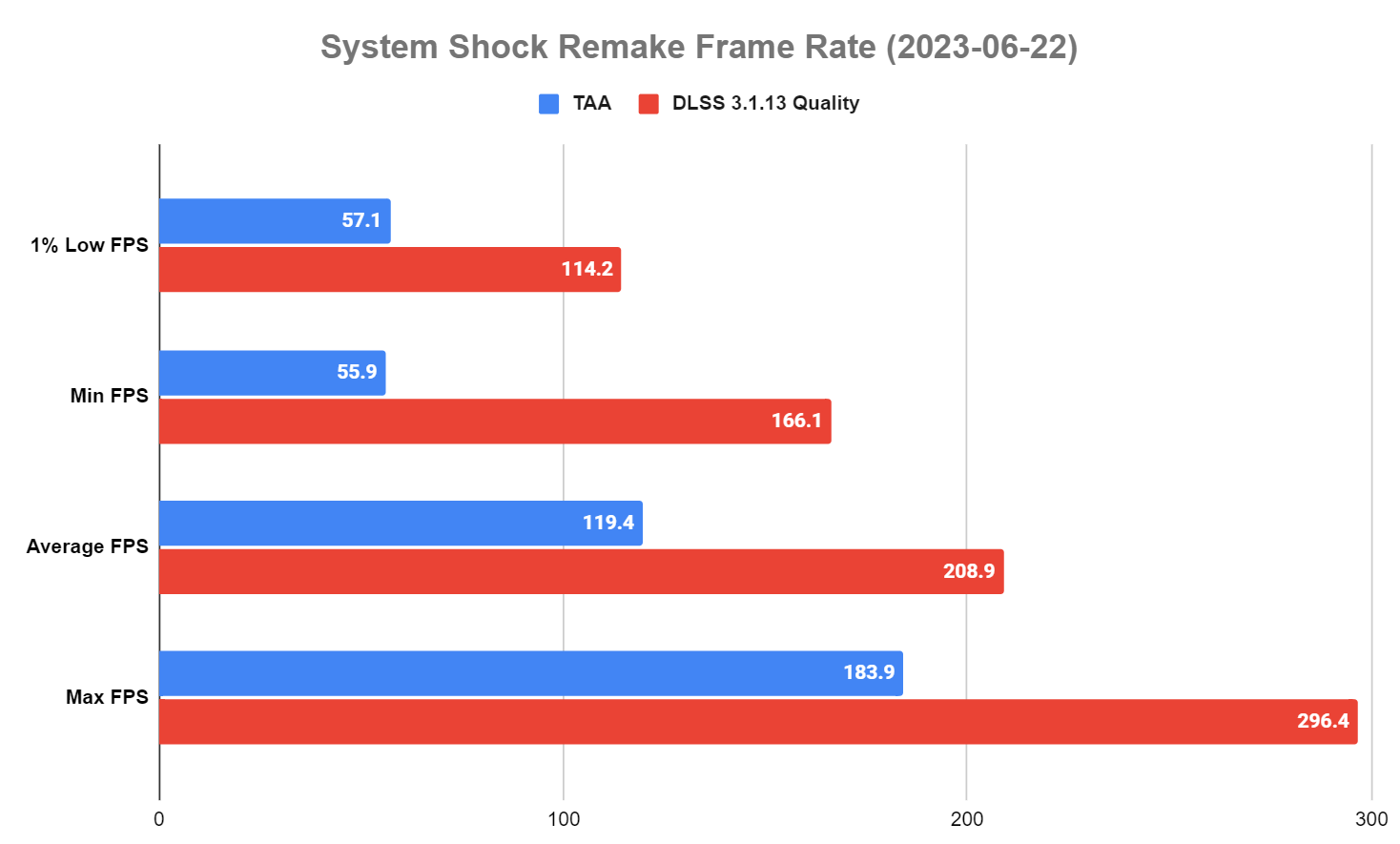
And the frame times, first with max TAA and below that with DLSS 3.1.13 Quality.


Overall the performance numbers for this game are disappointing. The demos ran considerably better. Those 1% lows and minimum frame rates without DLSS are appalling for the hardware I was running it on (especially considering the nearly Valheim-like graphics), but those frame rate drops were both mostly related to stutter, which is a problem of its own. Of course, all the blame can’t be put on Nightdive for subpar performance; Unreal Engine 4’s renderers are very outdated at this point, and Nightdive struggled enough releasing the game as is so I wouldn’t have asked for an Unreal Engine 5 upgrade for this game (though it’s usually a lot less work than people without Unreal Engine experience imagine).
Unfortunately I wasn’t able to hook into the game with NVIDIA NSight to try and determine why DLAA destroys performance, thanks to Steam DRM. I thought I had requested a GOG version of the game initially, but I guess not!
System Shock remake uses XAudio 2.9 and my first impressions of its sound quality were how delighted I was to hear good, accurate spatial audio on my 5 channel surround sound system. Some of the best I’ve heard in a while. In this survival horror game with mostly dynamic enemy encounters, this saved my life countless times by allowing me to hear enemy noises including footsteps behind me or to my sides.
There’s no Dolby Atmos though, and due to its choice of XAudio 2.9 it has no support for ray traced audio via AMD TrueAudio Next, which is a shame because this is open source and available as a plugin for Unreal Engine 4 via Steam Audio, which only seems to be evaluated and used by VR game developers for some reason.
Sound effects quality is overall great. Melee weapons deliver powerful impact, guns sound more like actual guns than in most games, and there’s some nice attention to detail such as penetrator rounds for the assault rifle having a slightly different sound than the normal ammo.
From a sound quality perspective, the main shortcoming is that physics object collisions make very little sound, a problem found in most games. The only games I’ve played that handle such dynamic object collision sounds realistically are Cryostasis: Sleep of Reason and all the games from Frictional Games, whose latest game will be the subject of my next review.
When it comes to the sound atmosphere, the game is not as quiet as Arkane’s Prey which nails the sound atmosphere for a space horror game – Prey has a lot of eerie silence. System Shock on the other hand often has ambient noise from equipment, but not everywhere and not on every level. It consistently uses ambient music which I find doesn’t add much to the atmosphere. Overall I found the soundtrack lacking and not adding much to the experience for most of the game.
Some but not most of the combat music is clearly System Shock 2 inspired techno, which might be fitting for old school cyberpunk but not fitting for survival horror combat.
There are no issues with the game’s voice acting. It’s only present in the intro, in audio logs, and in the few messages you receive, but it’s surprisingly good for an indie game (outsourced of course). SHODAN is revoiced by the original voice actress, Terri Brosius. This remake wouldn’t work otherwise.
Here is a technology overview table for System Shock remake.
| 64-bit | Yes |
|---|---|
| Linux Support | No |
| DRM Free Version Available | GOG Only (Steam version uses Steam DRM) |
| Graphics API | DirectX 11 |
| Frame Rate | Unlocked |
| High Resolution Support | Yes |
| Ultrawide Support | Yes |
| High Refresh Rate Support | Yes |
| Borderless Windowed Support | Yes |
| VR | No |
| Display HDR | Special K Required |
| Stutter | Mild (no PSO caching was performed) |
| Ray Tracing | No |
| Mesh Shader Virtual Geometry Pipeline | No |
| Micro-Meshes | No |
| Advanced Distance-Based Level Streaming System with No Loading Screens | No |
| Loading Times | Very fast |
| Variable Rate Shading | No |
| Sampler Feedback Tiled Texture Streaming | No |
| Sampler Feedback Texture-Space Shading | No |
| DirectStorage/RTXIO | No |
| Multicore CPU Support | 4-8 cores |
| GPU Physics | No |
| Adjustable FOV | Yes |
| Anisotropic Filtering | None |
| Anti-Aliasing and Upscaling | DLSS without DLAA TAA (always enabled, conflicts with DLSS, config file edits required to disable) |
| DLSS/FSR/XeSS Used for Dynamic Resolution? | No, presets only |
| Sound API | XAudio 2.9 |
| Sound | Up to 7 channels |
| Dolby Atmos | No |
| UI Scaling | Yes |
| “Analog” Keyboard Support | No |
| Compressed Game Files | None |
| Approximate Game Install Size | 8.8 GB |
| Debug Console | No |
| Modding | Very limited |
My overall conclusion about System Shock remake is that it is good, but not great. It is certainly the second best overall Shock series game, and that includes Arkane’s Prey, but the distance between it and System Shock 2 is immense.
The biggest issues with the game stem from its hardest difficulty modes being far too easy with regards to enemy encounter design, unacceptable gimped Cyborg Assassin and Cyborg Mantis AI compared to the demos, oversimplified repetitive AI (almost all of it just slowly walks towards you shooting like a terminator with no self-preservation instinct, which wastes the game’s strong enemy model diversity), Research is just a very weakly designed level with only generic enemy encounters, Maintenance and Storage levels also suffer from uncreative enemy placement and also a nearly complete lack of enemy diversity.
The game completely relies on its optional 10 hour time limit in order to work as a survival horror game beyond level 1. It does work then at least. That is the best way to play the game, but it is difficult to recommend to System Shock first timers (even if you’ve played 2).
I give this game a recommendation, but not a glowing one. No need to rush out and play it, but do play it if you like FPS games and survival horror, and it is one of the better games released in the last decade and a half. It is interesting to see how much more the game could’ve been, looking at Nightdive’s ideas for the game that didn’t make it.
Strengths
- Gameplay
- Very good weapon design and diversity, far surpassing most modern games
- Weapon upgrade system isn’t great, but it does improve the gameplay slightly
- Very high enemy diversity except for an extremely similar, oversimplified AI being used across the vast majority of them
- Works well (but not brilliantly well) as a survival horror game when using the optional 10 hour time limit (mission difficulty 3)
- Grenade cooking
- Hardware upgrades like sensaround, projectile shield, turbo-motion boots, target identifier improve gameplay
- Cyberspace is cool and creative, overall well done except for the final boss fight cyberspace portion
- Very granular difficulty options that are well explained, although still missing some important features like limited saving
- Level Design
- Above average level design with a respectable amount of depth and many secrets on every level except Research
- Audio, Visuals, Technical
- Great surround sound spatialization
- Overall very good sound quality with a few exceptions
- Some nice details in art design, such as every level looking unique (addressing a weakness of System Shock 2)
Weaknesses
- Bugs and Performance Issues
- Some stuttering when loading new areas on a level, e.g. opening a door. PSO caching was not performed as recommended by Epic Games and Microsoft, presumably due to not reading engine documentation or they assumed they wouldn’t need it.
- Underperforms for the given graphics fidelity, unsurprising for a low budget UE4 game though. Not the worst offender.
- UI bugs in the media menu
- Clipping issues, some of which can get you killed – I clipped out of bounds and died both in cyberspace and realspace, and a Gorilla Tiger damaged me through a wall repeatedly.
- If you explore with your turbo motion boots, you can find some non-solid ground
- Physics bugs – jumping can result in you getting flung to your death.
- Part of the UI is unusable for me and I play on fullscreen on a 16:9 resolution, so it’s not like I have a bizarre setup. With the inventory open, the popup windows for the abilities on the right hand side go off the screen due to bad design (not a bug).
- The game can crash – I had one in one playthrough. Still more stable than Arkane’s Prey though.
- Gameplay and AI
- Completely ruined Cyborg Assassin AI – they are now generic Terminators who slowly walk towards you trying to destroy you, whereas the demo had more appropriate AI that would fire a proximity mine, then retreat and try to ambush you making for elusive cat and mouse gameplay. They pose absolutely no threat now.
- Ruined Cyborg Mantis AI – it was a far more effective ambusher in the demo where they would stay hidden for longer, then leap out and deal significant damage to unsuspecting players. They also used their leaping attack more in the demo to cover distance better, making them difficult to escape from. Now you can just slowly walk backwards and gun them down effortlessly. They pose absolutely no threat and it’s almost impossible to be damaged by a Mantis.
- Cortex Reavers are helpless if you have cover
- Cyborg Drone AI is too simple and needs to actually work together, learning from games like Half-Life 2. Not all Drones should walk towards you shooting – some should stand back and provide covering fire, and others should flank. Also, Sparqbeam wielding Drones should switch to maximum charge level up close.
- Cyborg Enforcer path finding is broken, so they too are no threat.
- Avian Mutant AI needs a complete rework
- Cyborg Enforcers, Cyborg Warriors, Cyborg Elite Guards, and Mutated Cyborgs are underutilized, only appearing in force on the last three levels except for the Elite Guards who only appear on the final level and are by far the most interesting enemy to fight. The game needs not only a huge AI rework but it needs more mixed, savage encounters like System Shock 2 has.
- Assassins like to blow themselves up with proximity mines, Enforcers like to disable themselves with their own EMP grenades. Elite Guards can also frag themselves.
- No enemy can enter crawl spaces, except for one scripted encounter. Even though some enemies would fit and some of them are supposed to, such as the scorpion-like maintenance bot.
- AI is ultimately too simple and repetitive – every enemy besides Reavers just slowly approach you like Terminators, whereas System Shock 2 has a variety of different AI for different enemies. There’s no high threat enemy outside of Cyberspace, an issue shared by some similar games: Arkane’s Prey and Dead Space.
- Excessive ammo quantity (including battery packs) on the hardest difficulty modes for a survival horror game. It needs an equivalent to System Shock 2’s Impossible difficulty mode for proper low resource survival horror.
- Melee mechanics aren’t as bad as some people claim, but they do need work. The laser rapier needs more visual feedback when striking an enemy.
- Remains over-animated – every time you pick up an audio log, it’s animated which takes control away from the character, removing you from the game in anti “immersive sim” fashion. Also, picking up an audio log makes you move very slowly which makes you vulnerable.
- Turbo motion boots are cool but a bit clunky because you can get stuck on any little crevice in the floor
- Non-junk items being labeled as junk is bad design. If you don’t want to handhold the player too much then abandon the “junk” label altogether and let the player try and figure it out. I didn’t think the debit cards were junk until I saw the junk label, so then I trusted the game which turned out to be dishonest.
- This one is a minor missed opportunity, but the assault rifle and rail gun should have had cool, sci-fi picture-in-picture scopes. The Skorpion should’ve had a Half-Life: Alyx style truly holographic sight upgrade.
- Final Cyberspace section is weak with infinite retries and no high stakes. Actually a much weaker ending segment than System Shock 2’s.
- No optional limited save system
- Very limited moddability and the game really needs a big overhaul like System Shock 2’s Rebalanced Skills and Disciplines mod and Scary Monsters AI mod
- Level Design
- Research feels empty and unfinished, with only generic encounters. Definitely the weakest level.
- Enemy encounters are quite boring and lack variety on Maintenance – far too much reliance on just the zero-grav family of mutants (especially the invisible ones). Mixed encounters are a must.
- Enemy encounters are quite boring and lack variety on Reactor Core – far too much reliance on just Hoppers. Mixed encounters are a must.
- From my understanding, many of these weaknesses are inherited from the original game which is an underlying issue: yes this is a remake, but some things needed improvement and lessons learned from SS2. Faithful to the point of weakness isn’t a good thing.
- UI Design
- Missing a universal graphics preset option, so you have to change them all individually
- Missing a “Recycle All” button, so you must individually place items in the recycling bin
- Cannot disable the crosshair and no reticle options
- No splitting items in inventory
- When you have two ammo boxes in your inventory with different amounts of ammo in each, it seems the game will usually (possibly always) start deducting from the larger box first which is illogical and creates unneeded inventory management.
- Audio, Visuals, Technical
- Cyberspace has permanent accessible mode. They made entering and exiting Cyberspace less enthralling and disorienting rather than making this an accessibility option. I prefer how it was in the demo.
- Inconsistent art design: modern shaders, modern post-processing, somewhat modern polygon counts on structures, 2000s polygon count on objects, 2000s texture resolution, 1990s pixelated texture filtering, yet it has modern 3D texture mapping like bump, parallax, and tessellation. Here’s a mod to fix the texture filtering. One of the main reasons to have a remake is to remake a game using newer, better technology.
- DLAA is not included even though they’re using the DLSS plugin which includes it. This is a constant issue in games, presumably because game developers have tunnel vision and don’t read documentation so they usually don’t even notice DLAA and don’t bother looking into what it does. They merely know “DLSS” is a hot seller so they add an option only for that, even though DLAA is part of the same plugin. You can enable it via INI tweaks but it’s unwise because it stutters uncontrollably when enabled and ruins performance, which is a bug.
- Missing a graphics option for TAA, so this is always on even when DLSS enabled, which effectively breaks DLSS and anti-aliasing as the two conflict. Disable TAA via an INI tweak if your system cannot run DLSS.
- HDR was a menu option in the older demo (albeit never enabled) yet never implemented. This means Nightdive was disingenuous with their demo and they failed to deliver on a promise. Do not re-enable it using INI tweaks since it breaks visuals, use Special K instead.
- I suppose global illumination is another dropped promise – it remains listed on the game’s Kickstarter.
- No particle lighting is a disappointing downgrade compared to many 2000s games. The particles would be beautiful if they were actual light sources.
- Can’t have pitch darkness even with broken light sources. Too much ambient static light. This is the unavoidable downside of not using real time global illumination, though it’s better than the alternative downside of there being no static indirect lighting resulting in areas not directly lit (even millimeters away from a light) being pitch black.
- Toggling V-Sync requires game restart for some reason, never seen this before in Unreal Engine 4
- Like every other Unreal Engine 4 game, this unfortunately doesn’t use the NVIDIA NvRTX branch of the engine, which I don’t think any game studio has ever even explored. The NvRTX branch could’ve substantially improved both graphics and performance – both performance and graphics by replacing Lightmass with the faster NVIDIA RTXDI (ReSTIR direct illumination) which would allow all light sources to be dynamic shadow casters. This also could’ve allowed for a nice optional global illumination solution (RTXGI – the old probe-based one which is also quite performant).
- Ineffective soundtrack usually adds very little to the atmosphere and overall experience for most of the game.
- Weak object collision sounds



